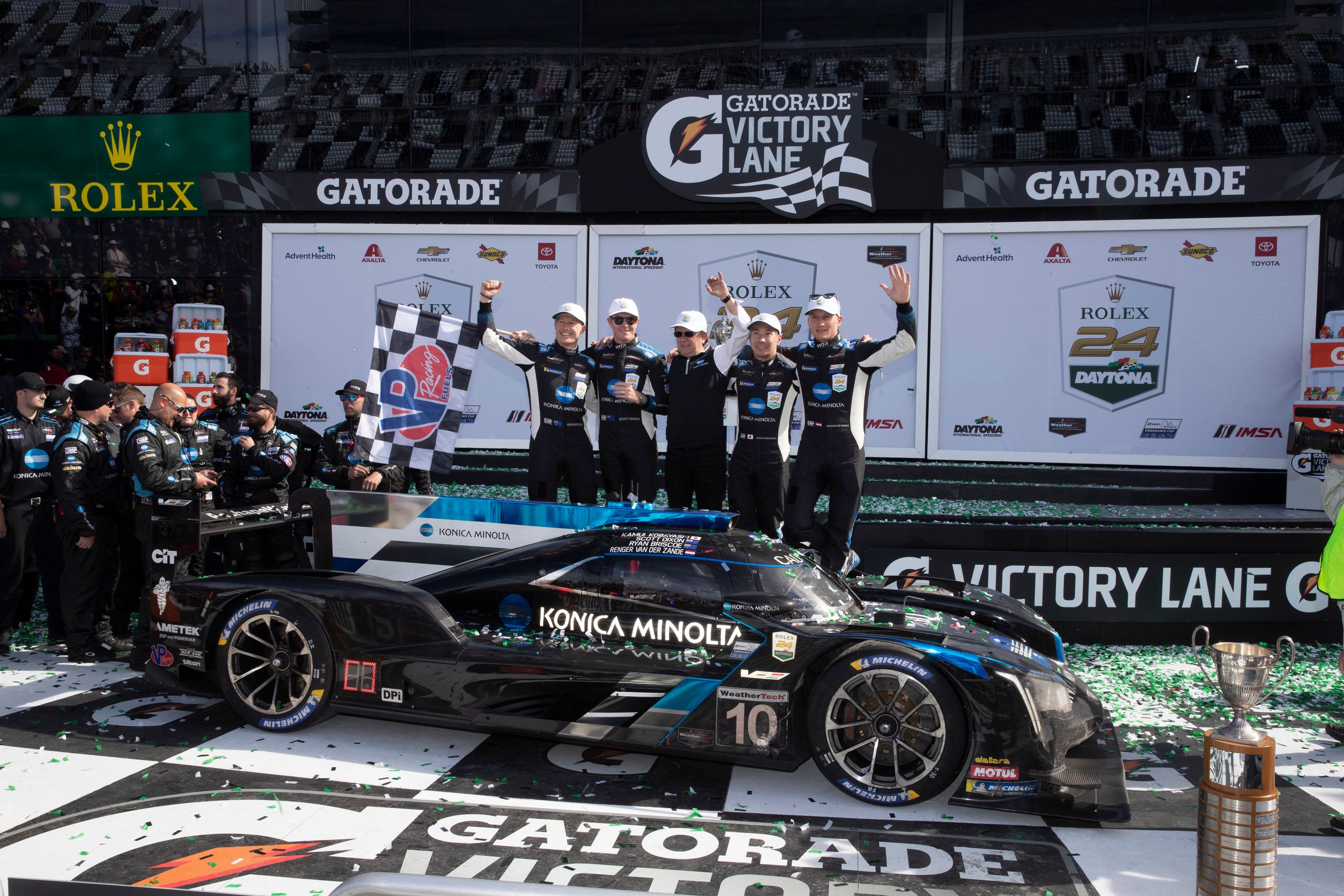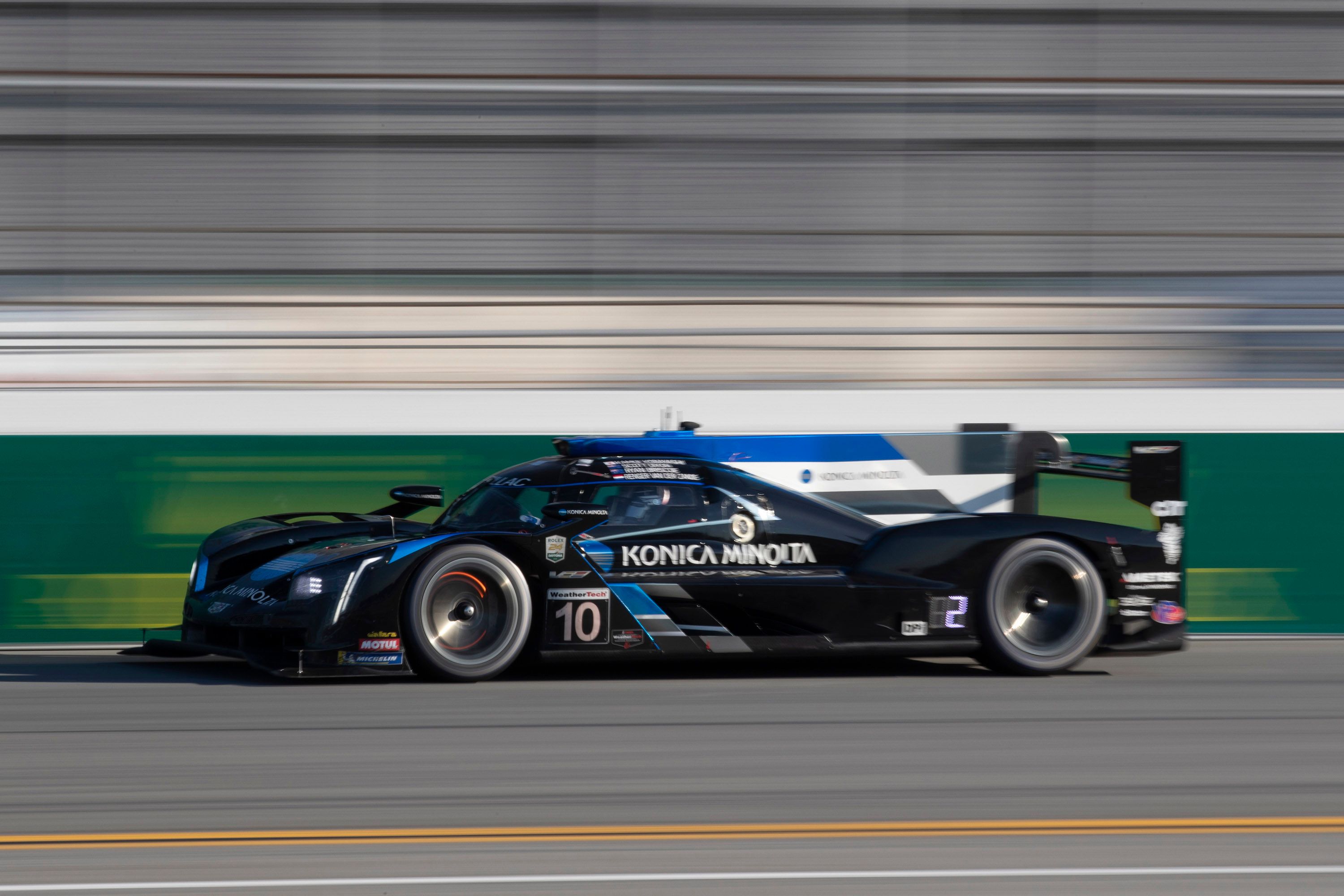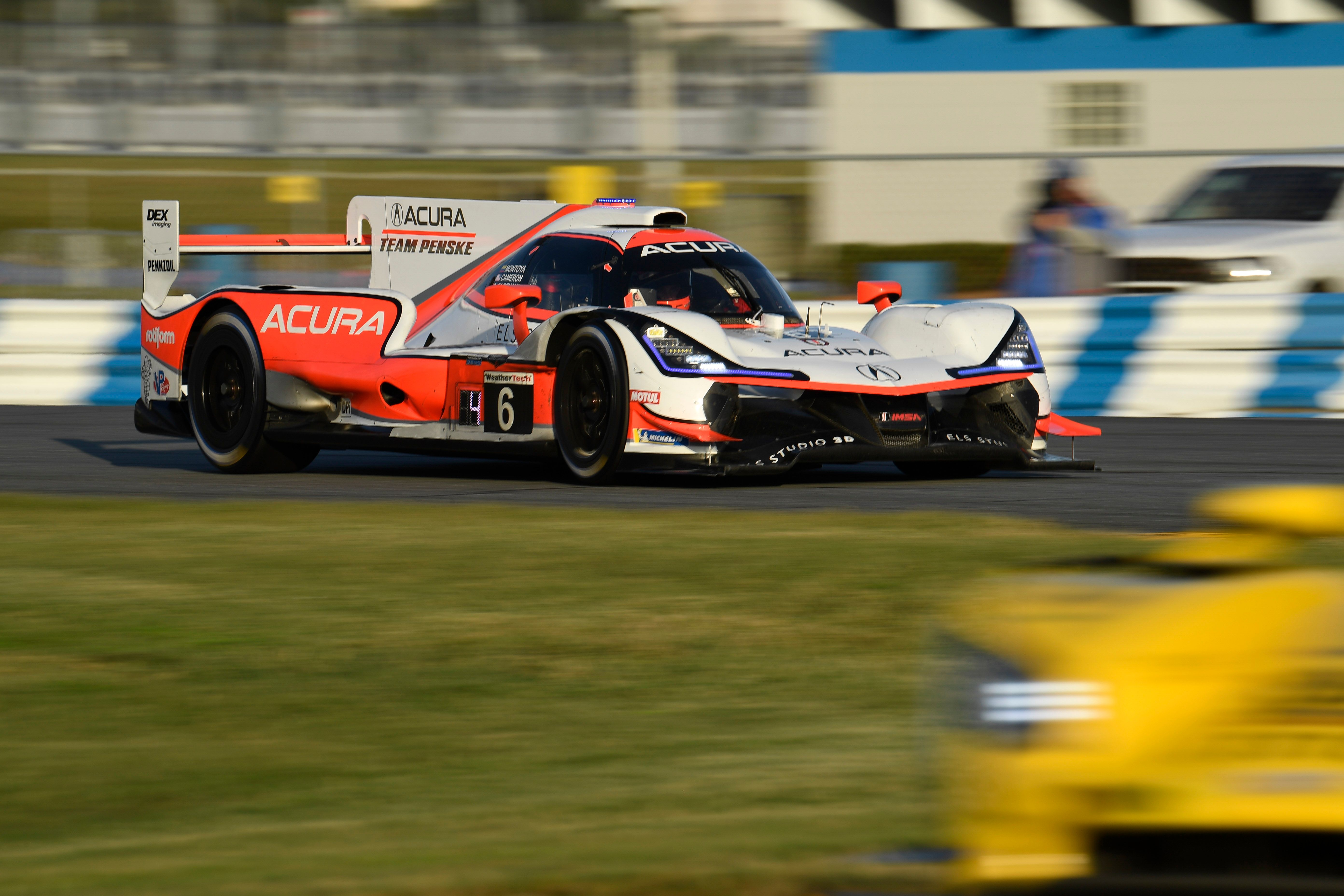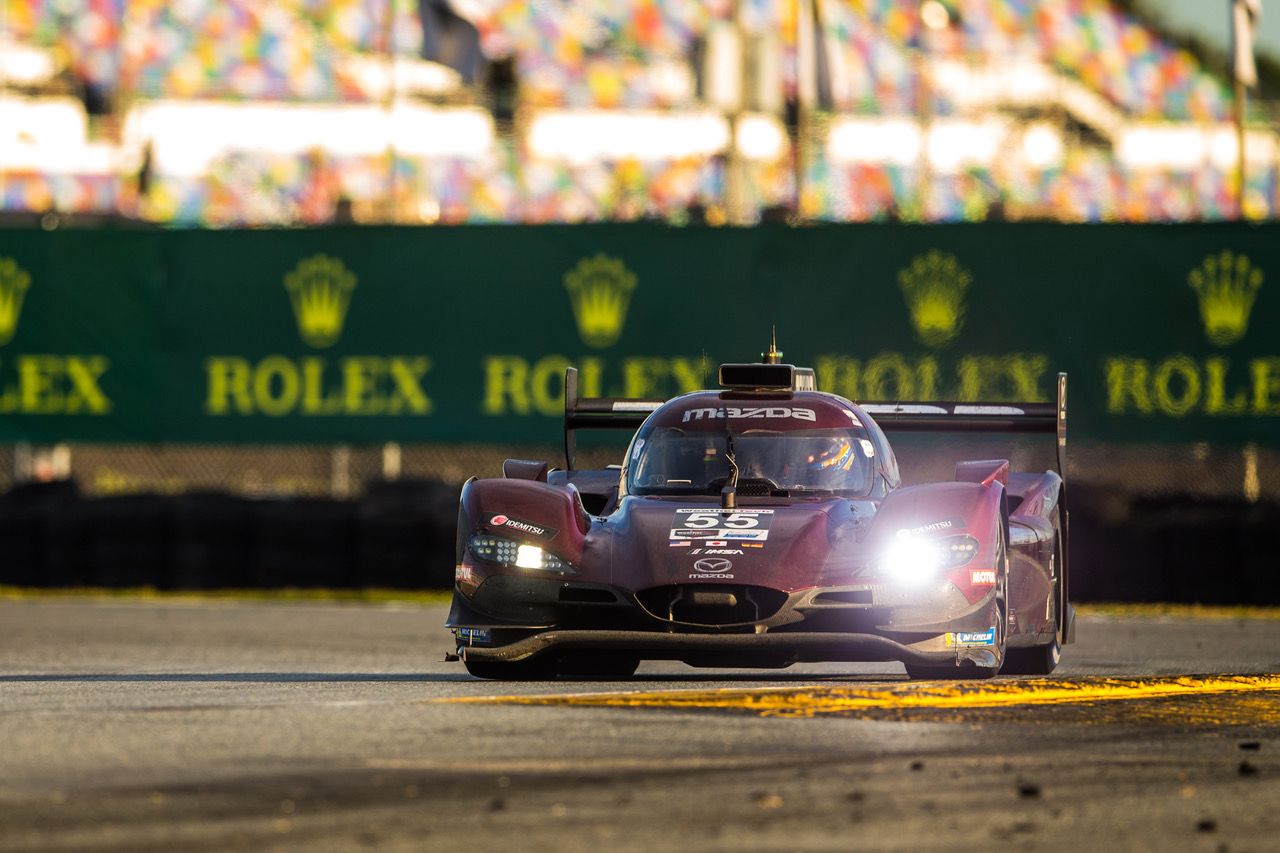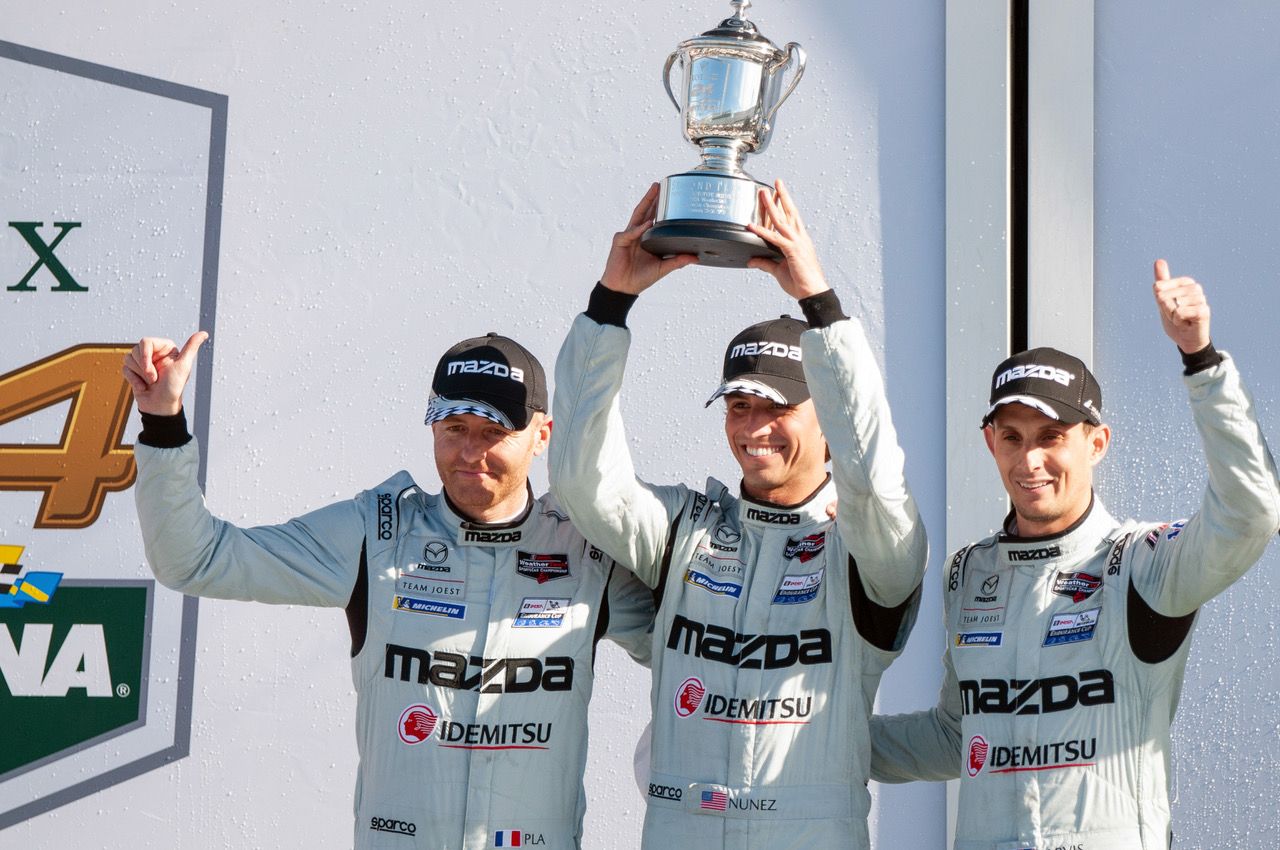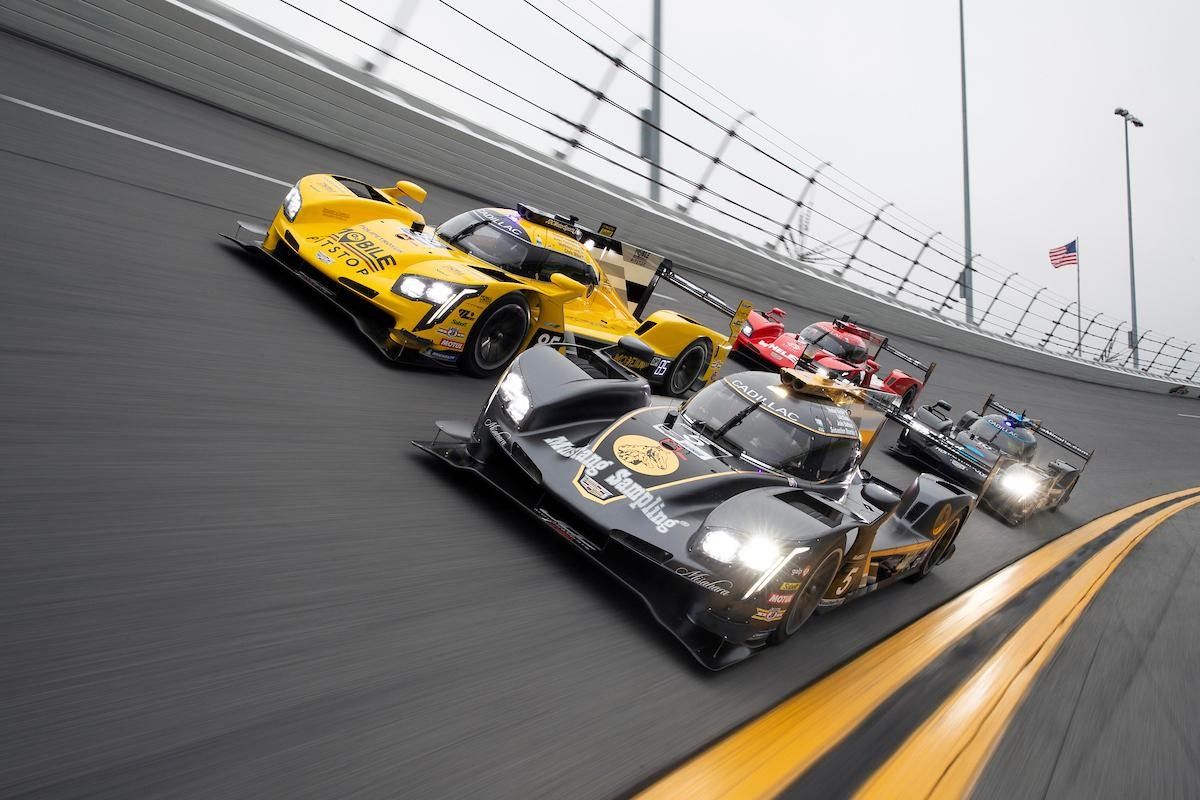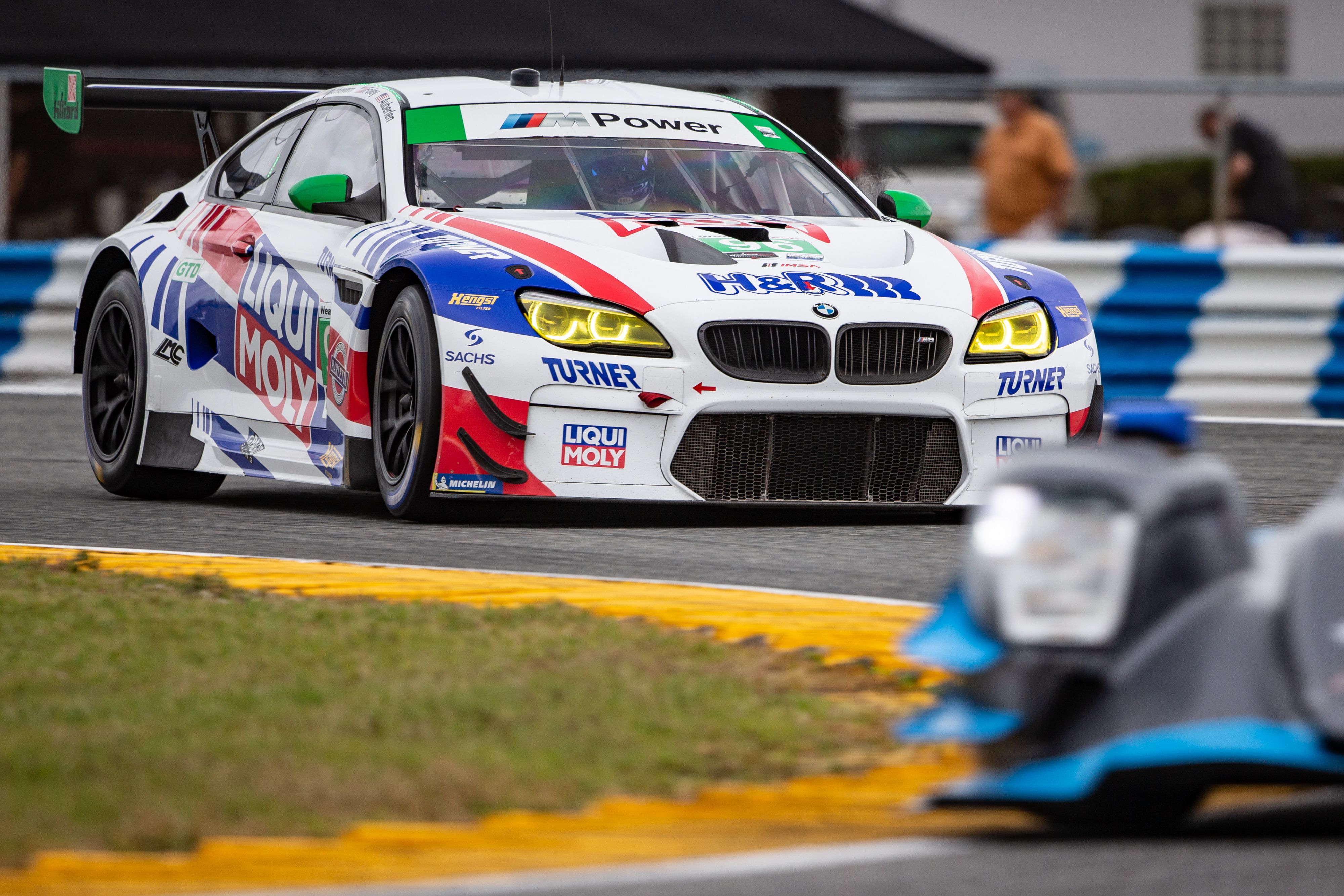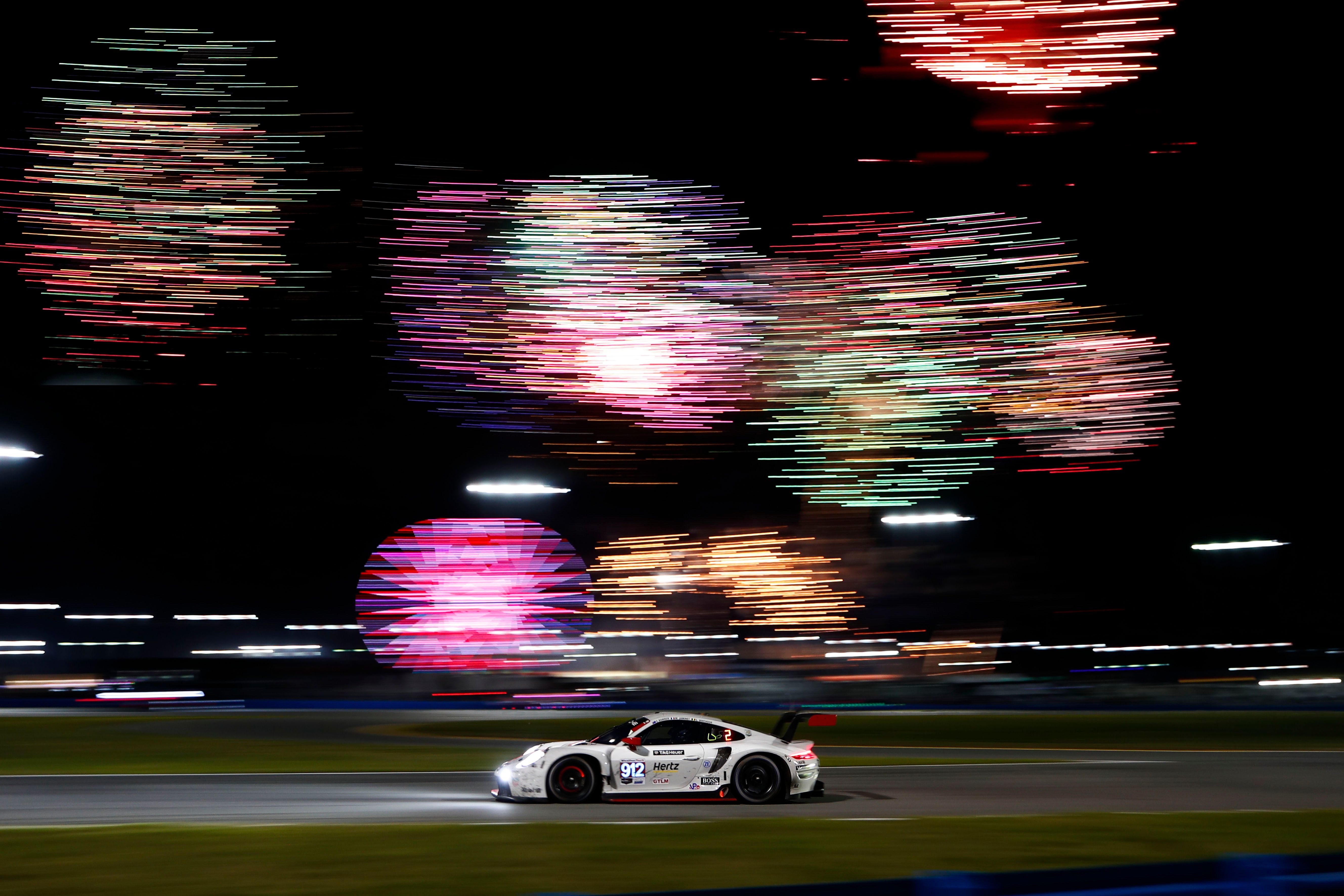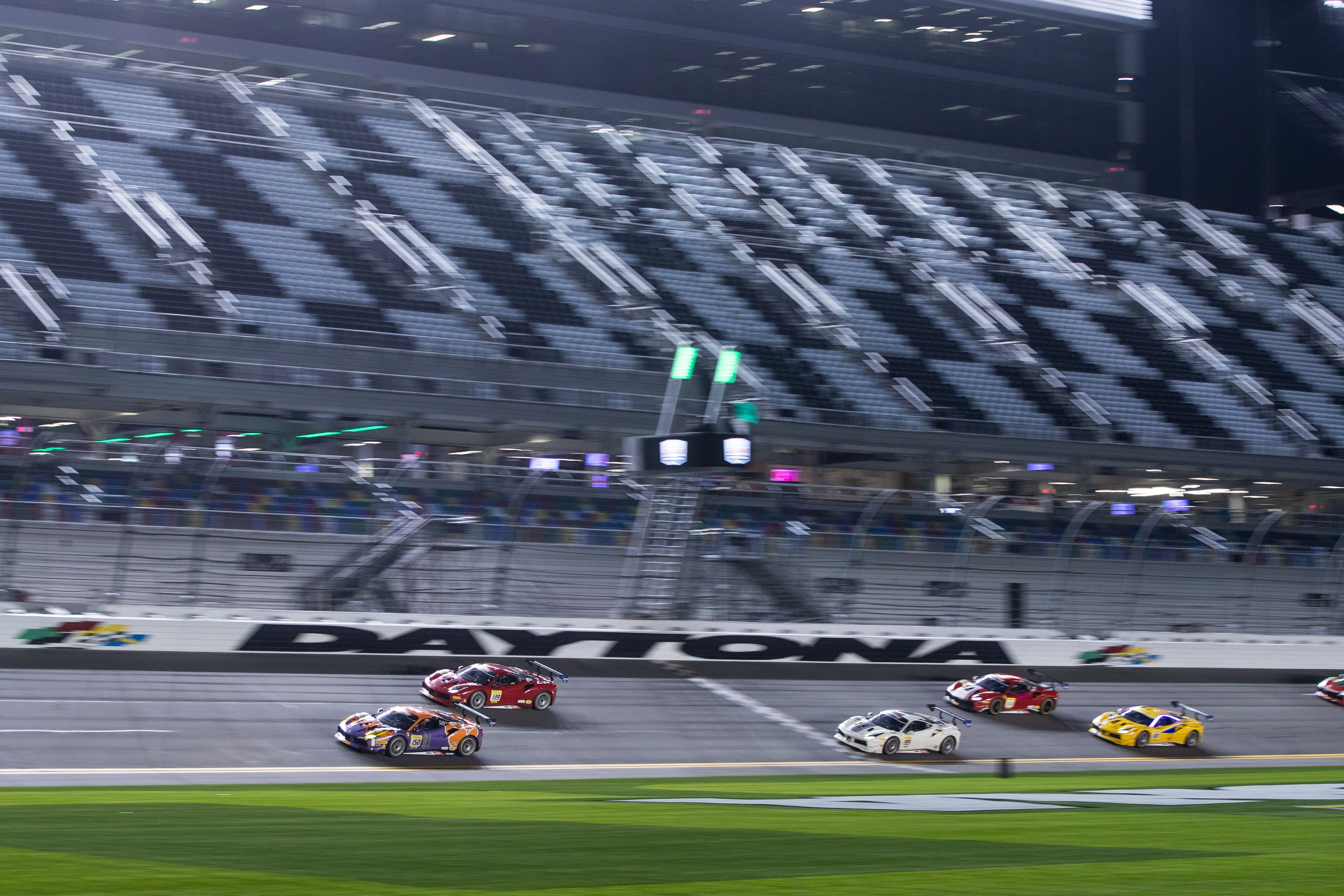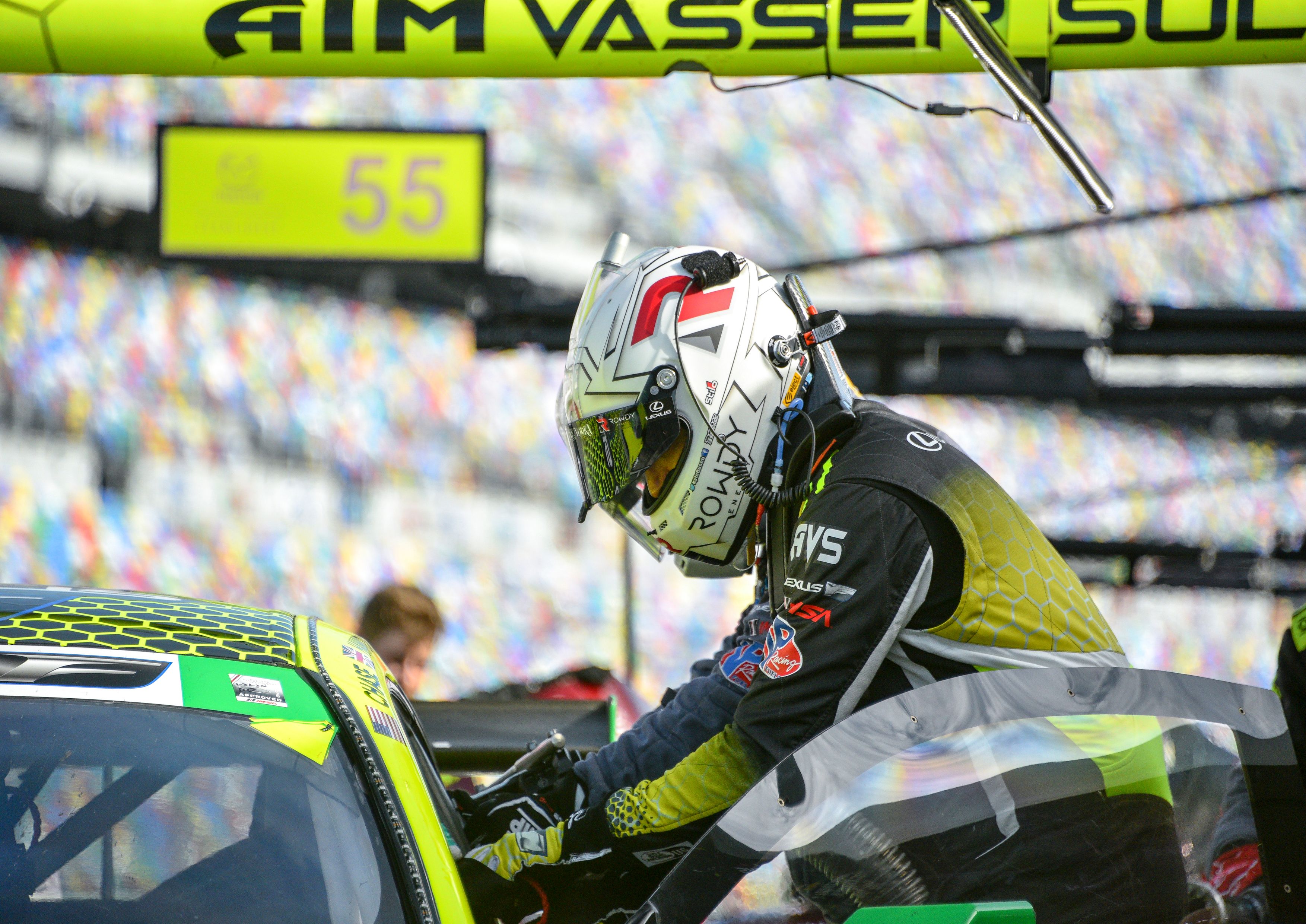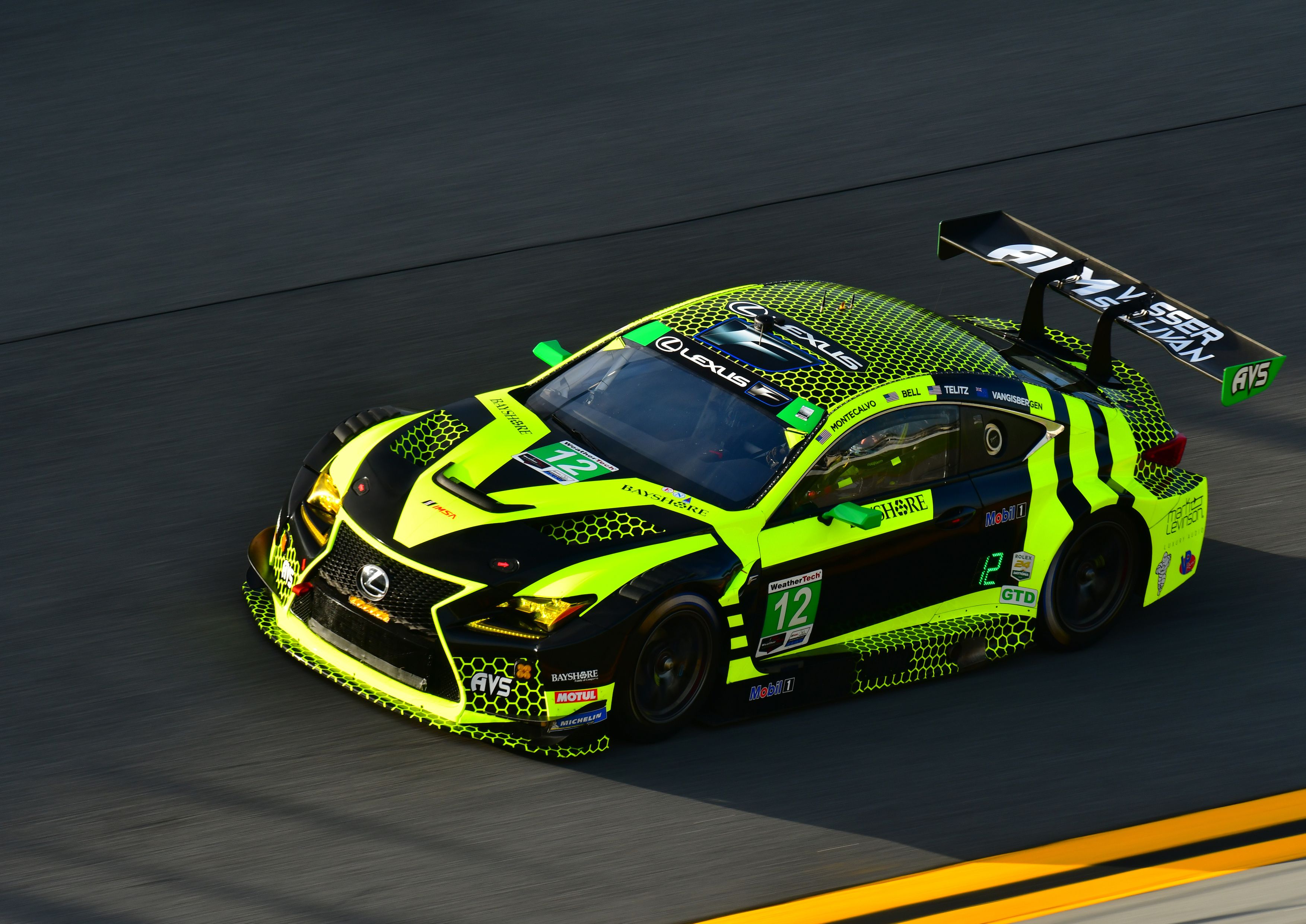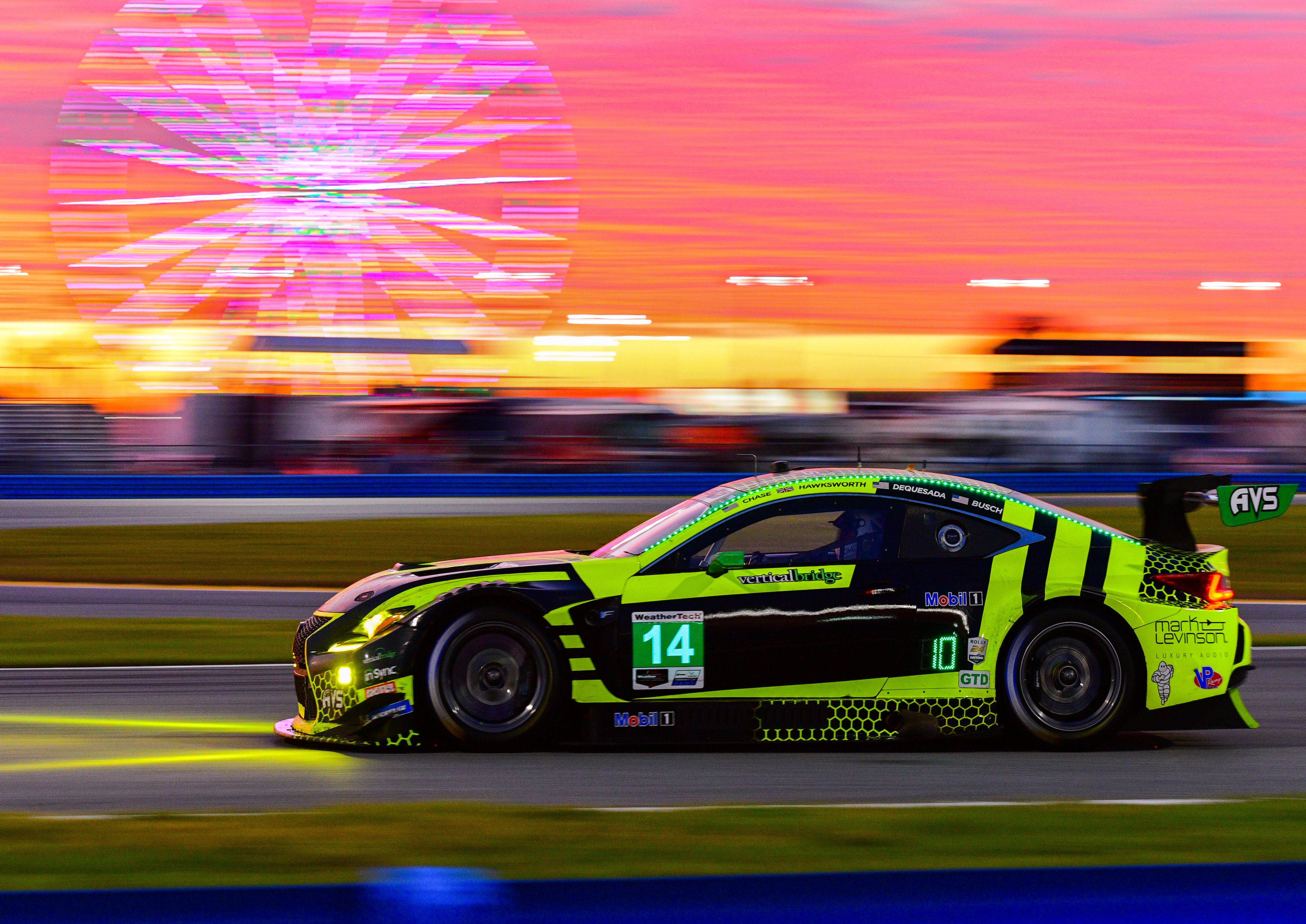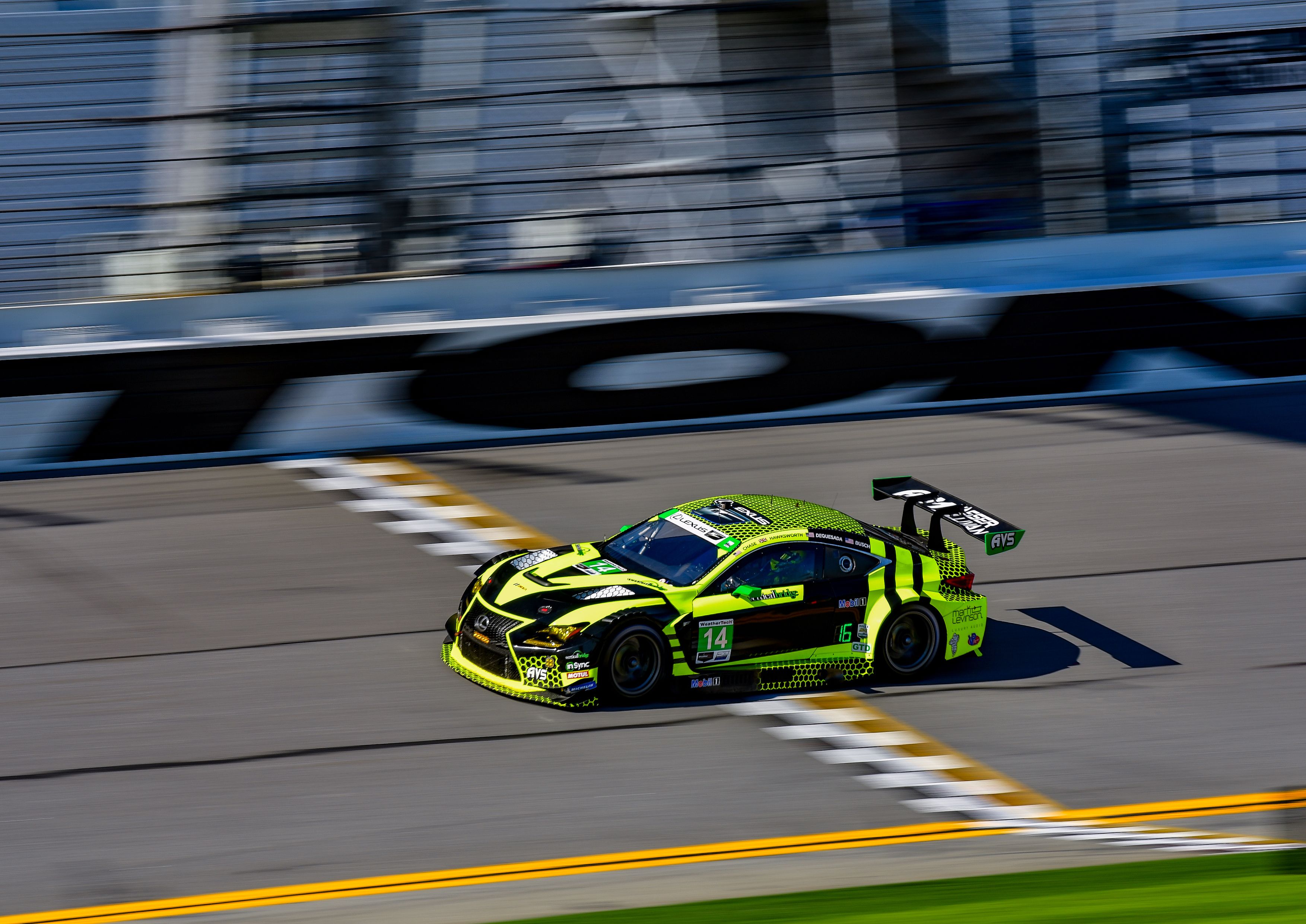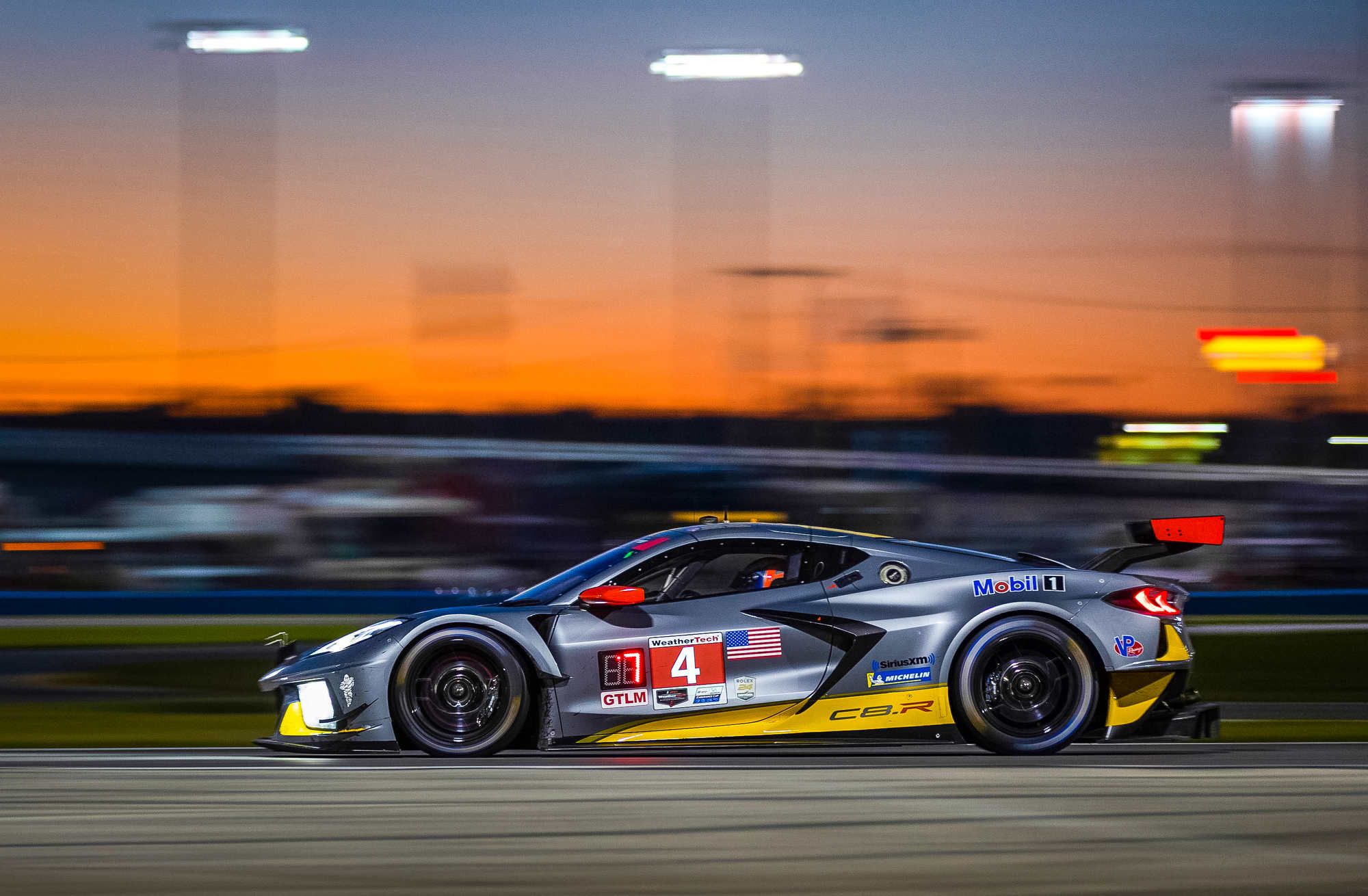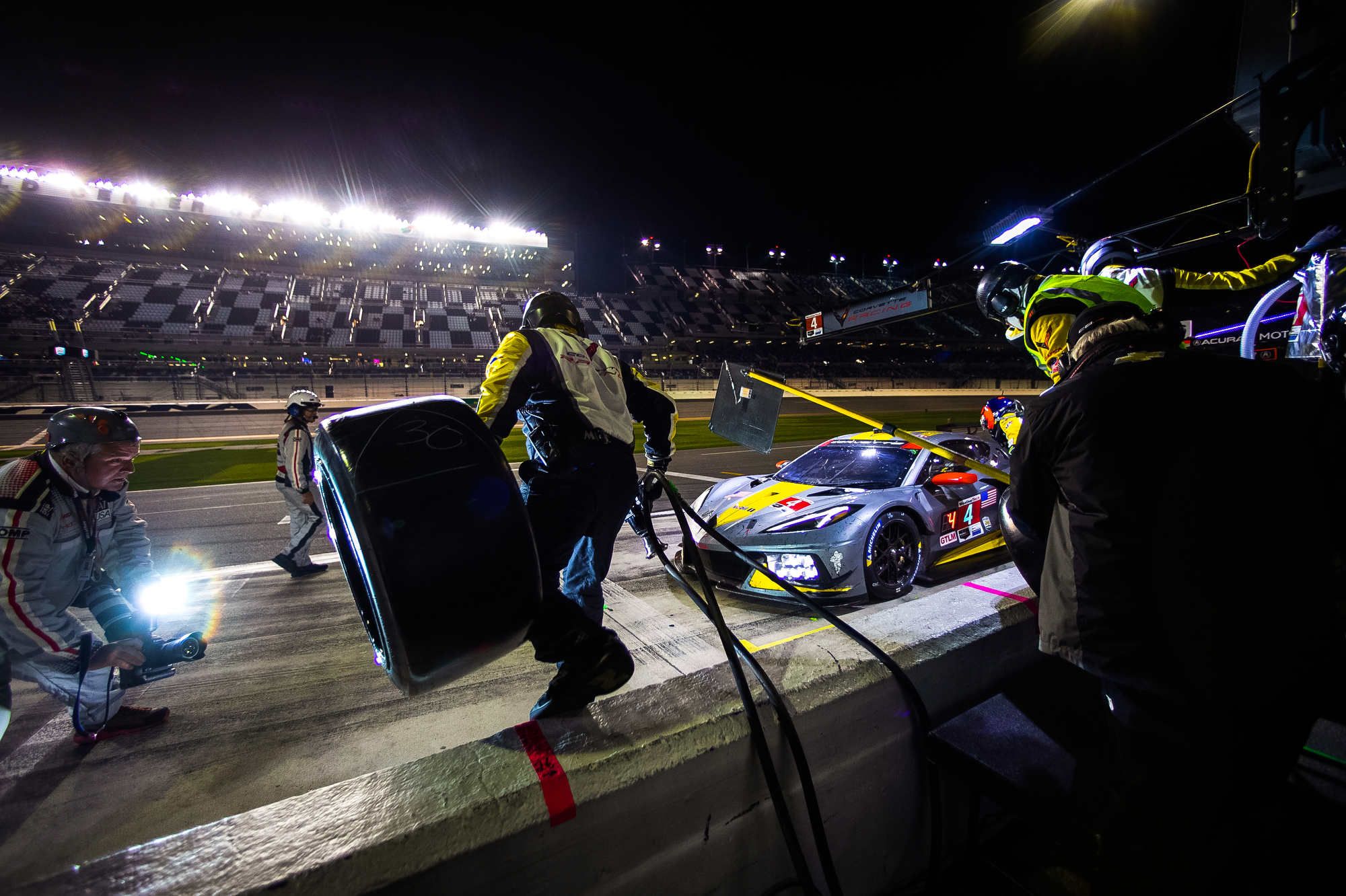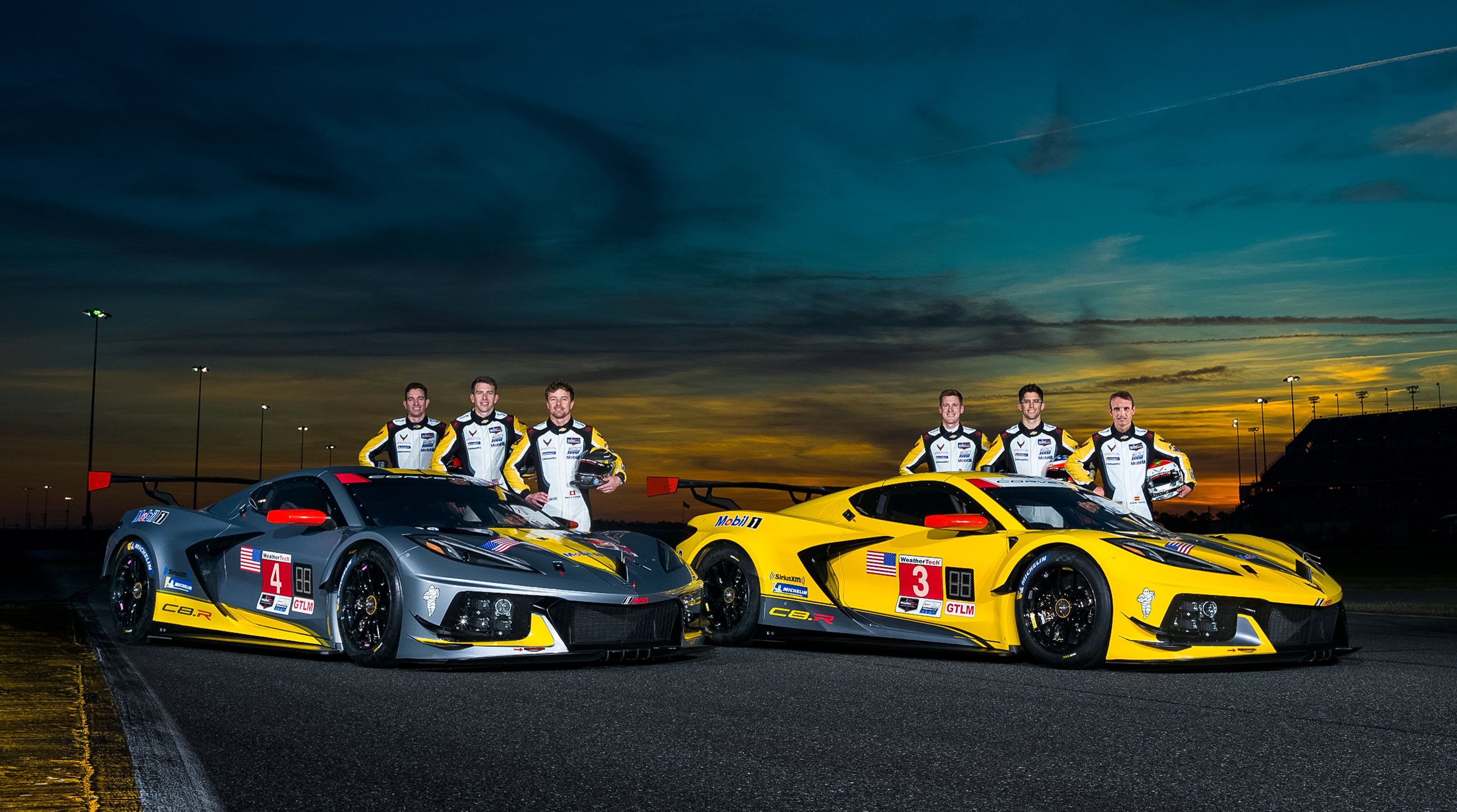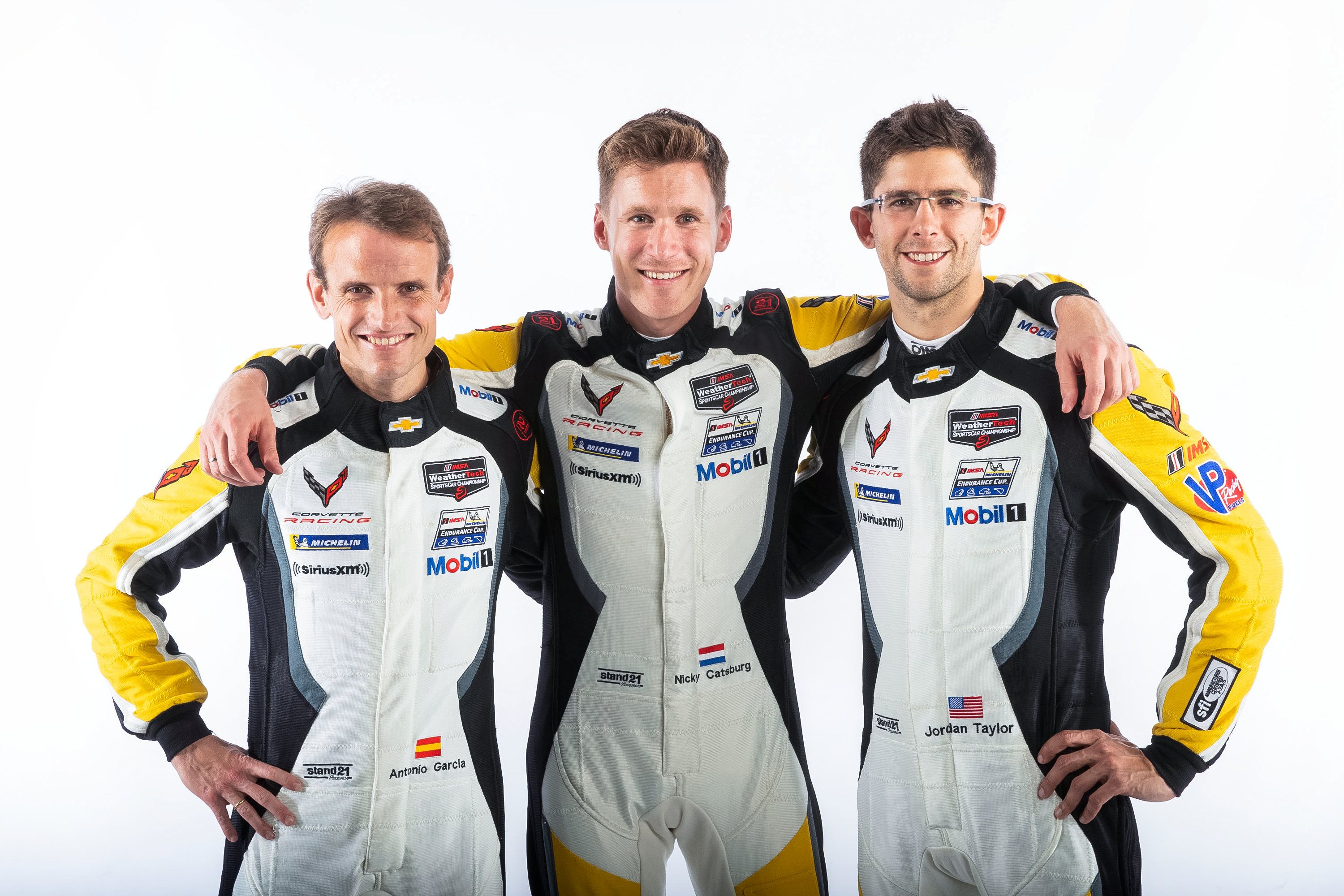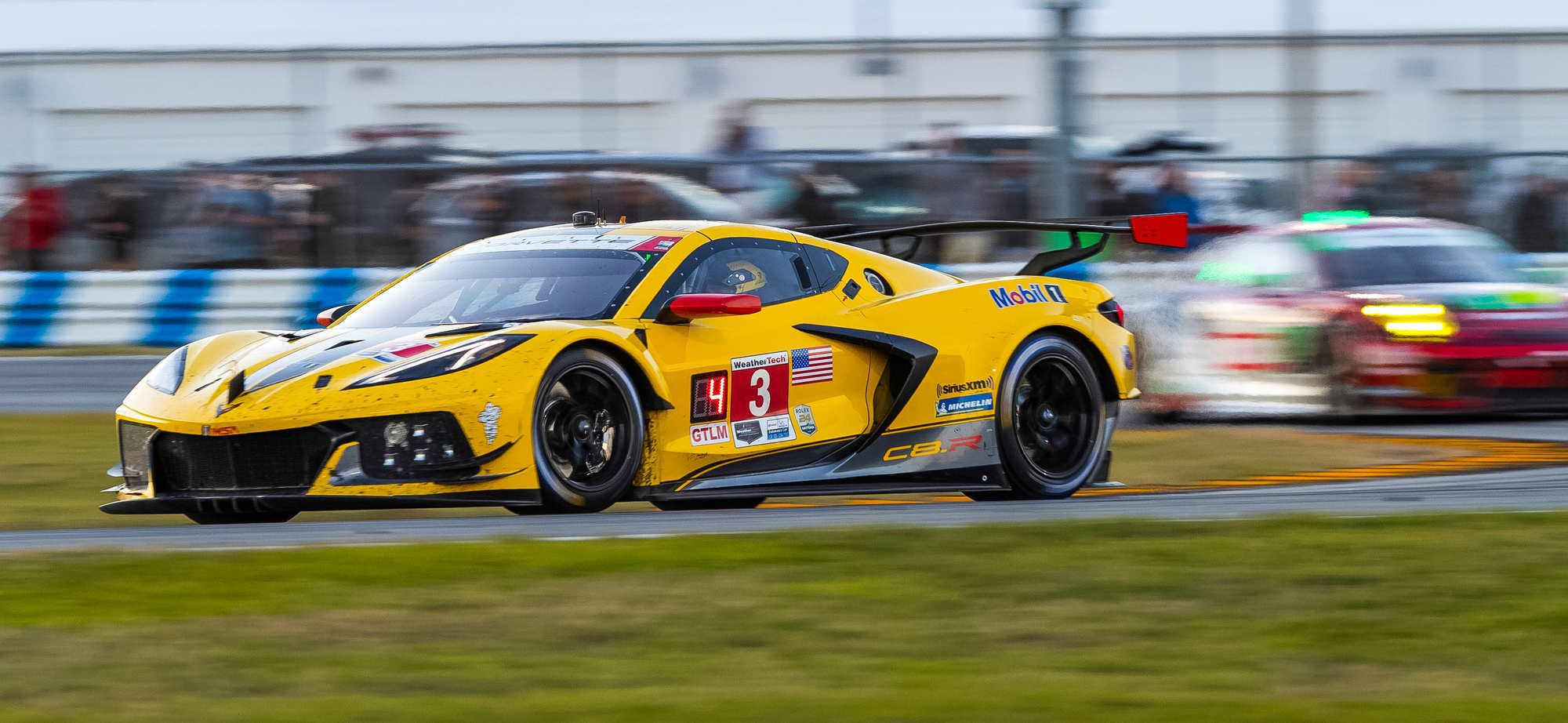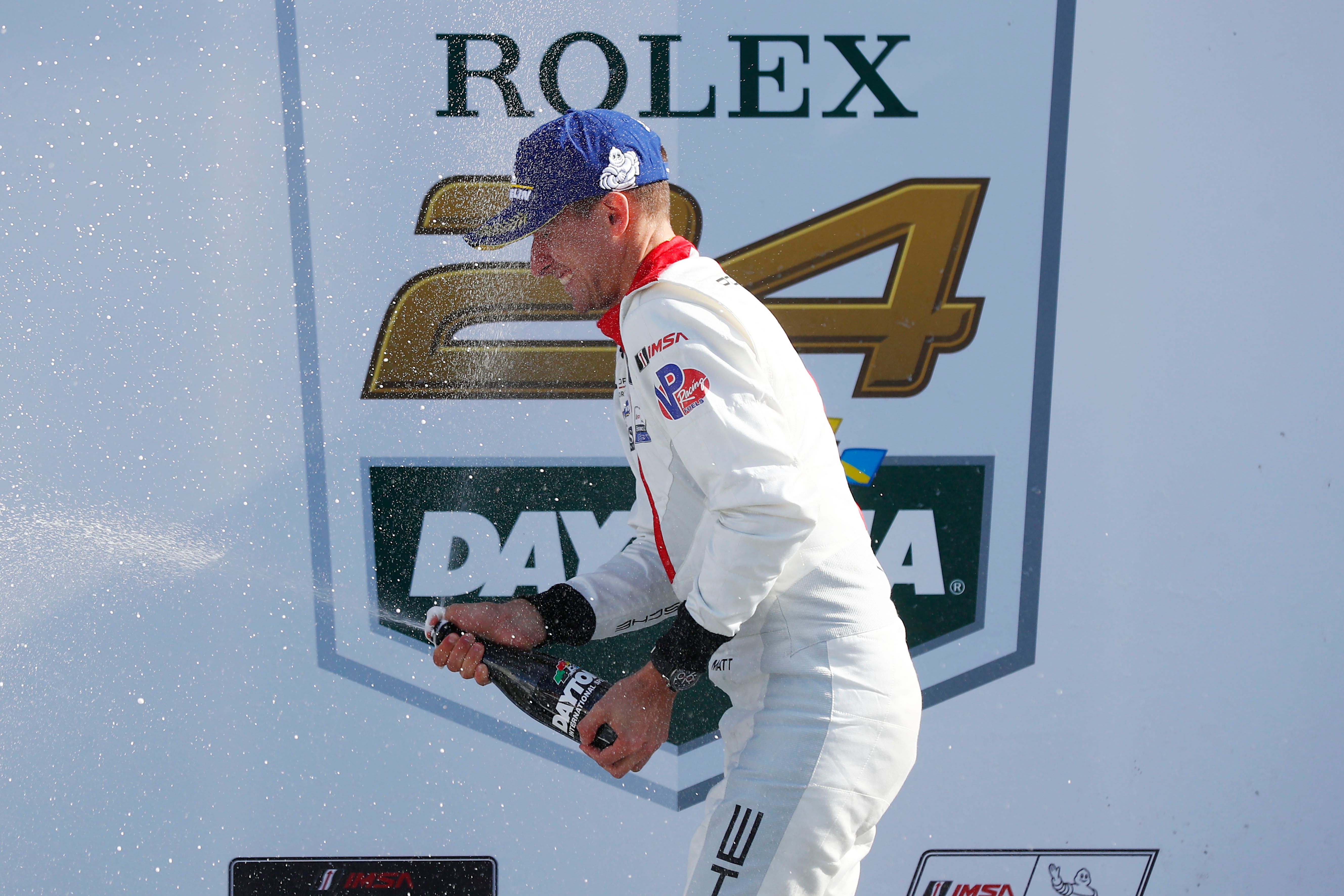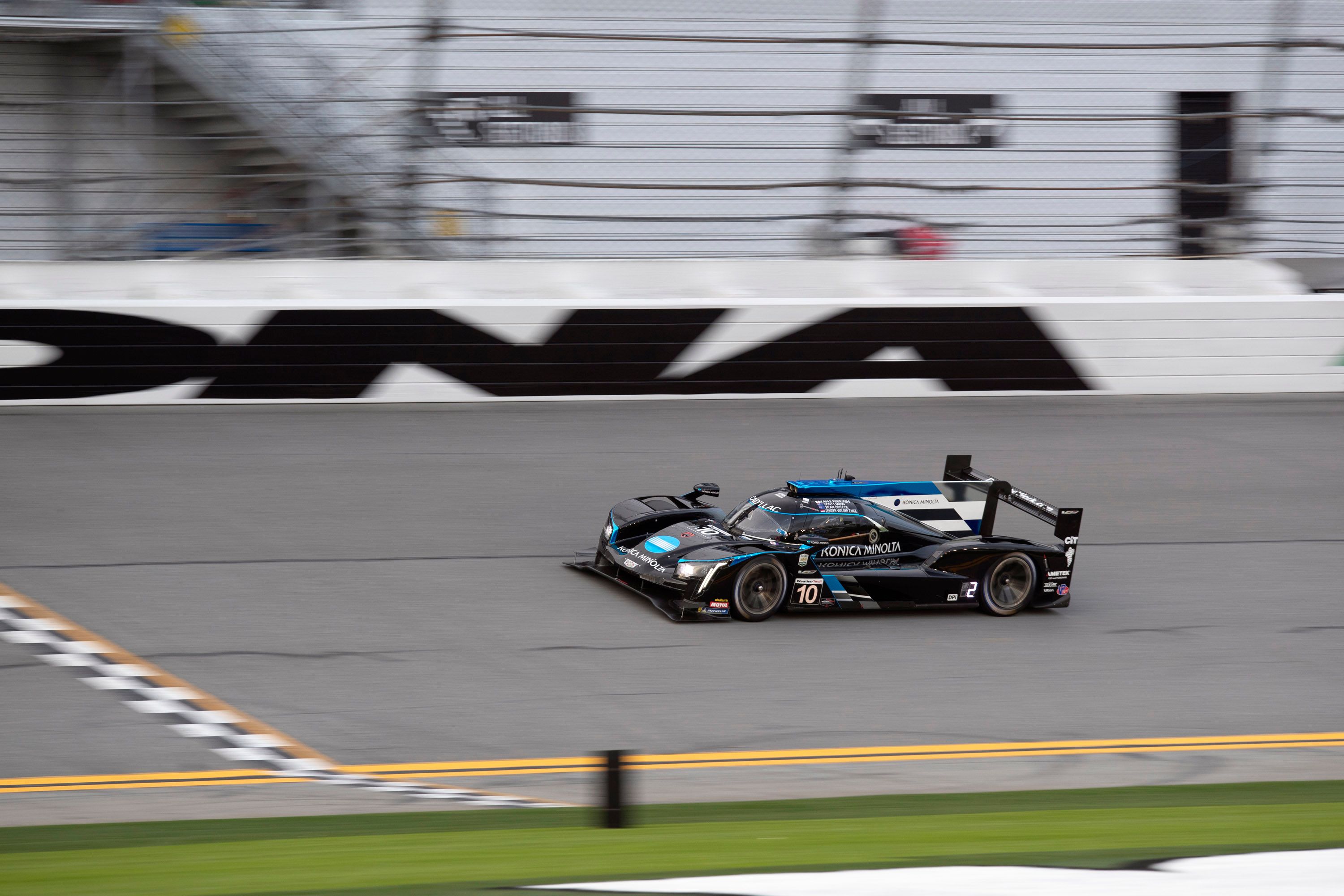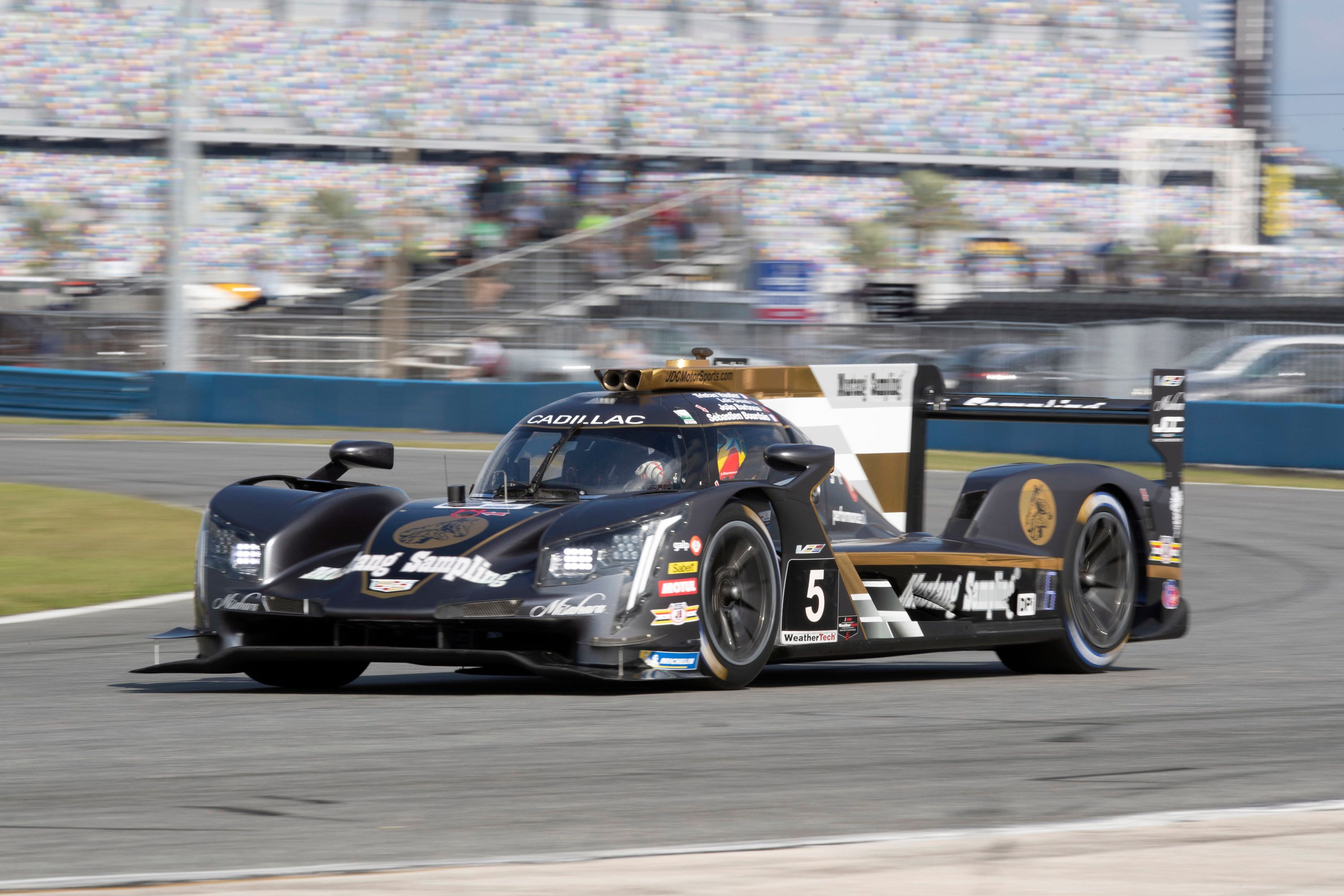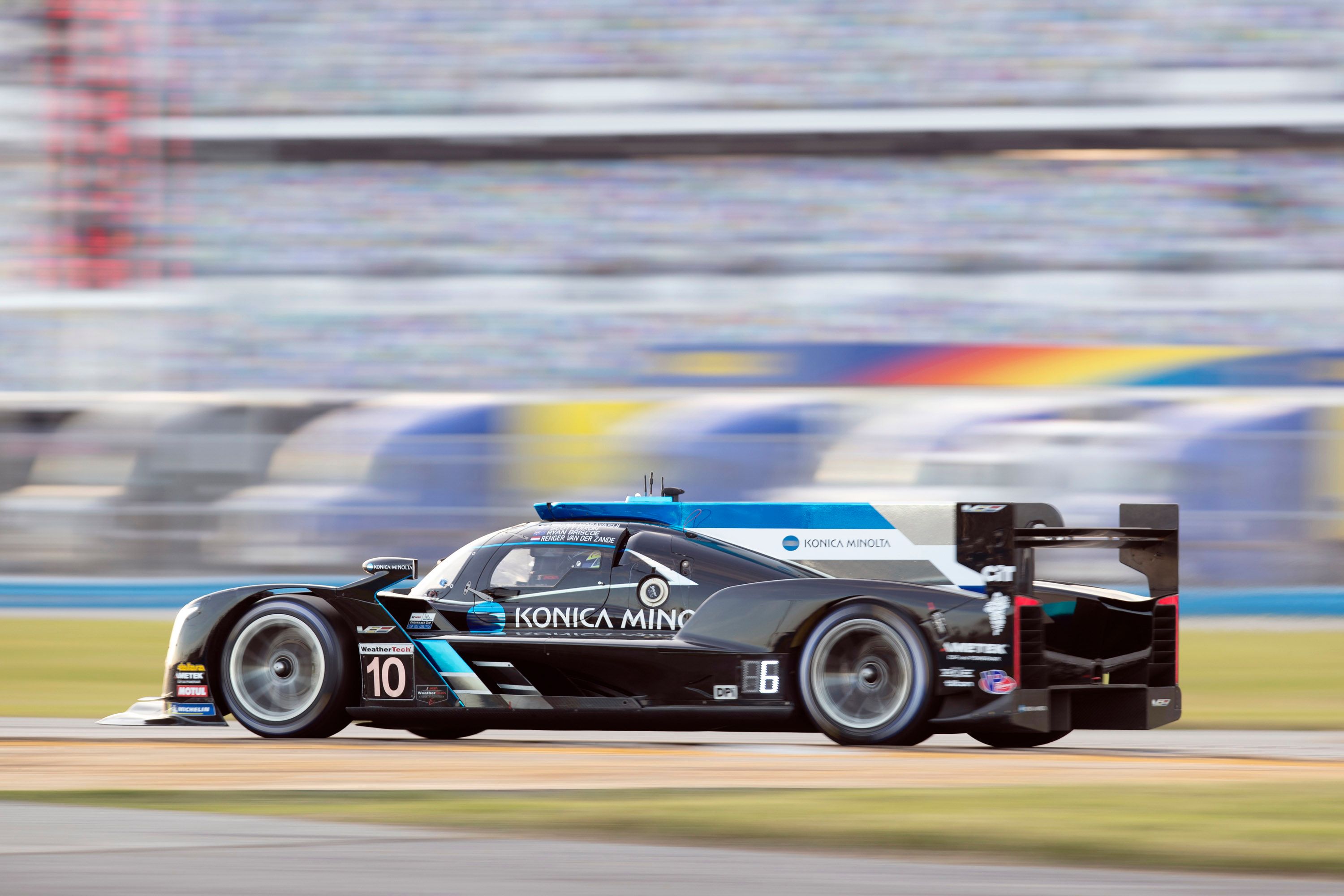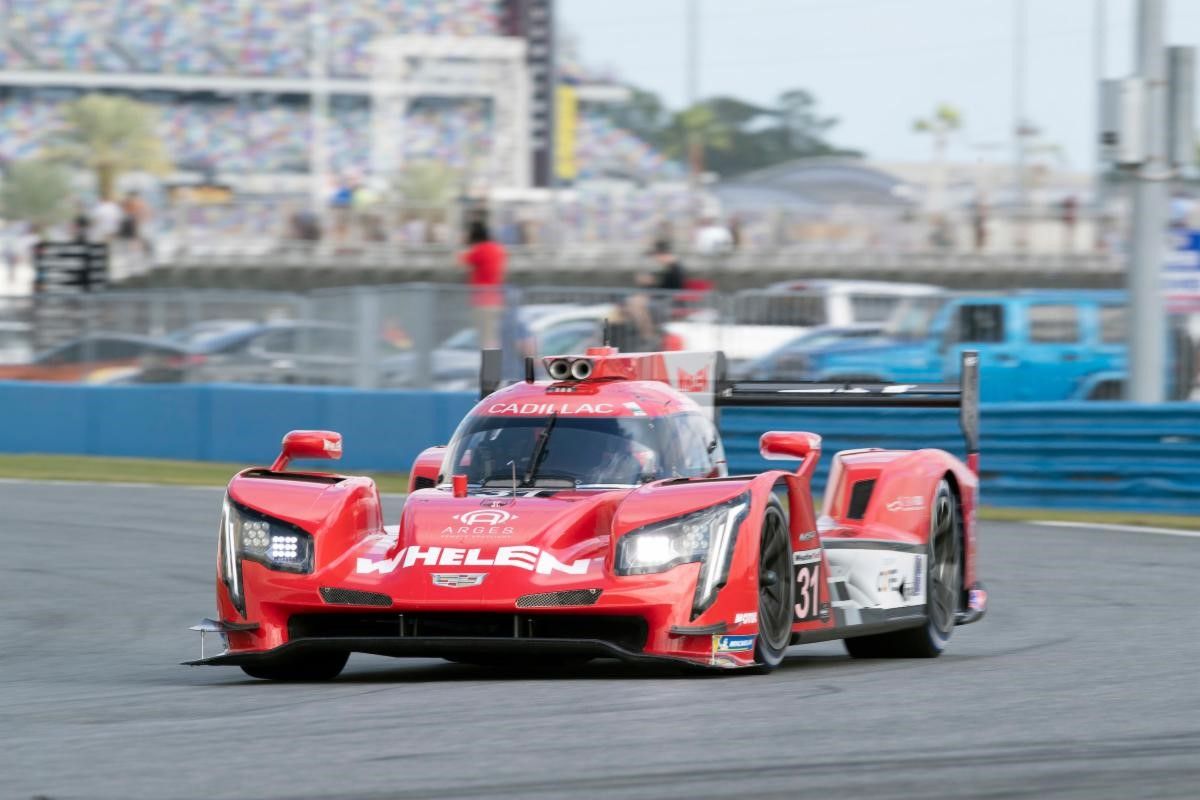The 58th edition of the legendary Rolex 24 Hours of Daytona, IMSA's annual curtain-raiser, wasn't as different from last year's race as you may think. Yes, there was no rain in sight and the running wasn't curtailed like in 2019 but quite a few of last year's storylines repeated themselves. We had the same outright winners in Wayne Taylor's Konica Minolta Cadillac team, albeit with a different driver roster, the same winners in LMP2 and in GTLM, and a Lamborghini won in GTD for the third year in a row. However, all of that was arguably eclipsed by a story that emerged even before the green flag fell to kick-off the event.
You cannot argue that January's Rolex 24 Hours of Daytona is a grueling race. It's the longest race in the IMSA Weathertech Sportscar Championship calendar and, to make matters worse for newcomers, it's round number 1 of the season. Given the illustrious history of the event, everyone wants to win here but reserving a spot in the history books isn't all that the drivers and teams involved are after as a lackluster run in the twice-around-the-clock race may as well ruin your season.
Down below you can read all about those that left Daytona International Speedway with a big grin on their faces after bathing in champagne in Victory Lane. You'll also find out all about how Corvette Racing's C8.R faired on its official debut and why endurance racing may well be heading into a new golden year within the next couple of years.
Wayne Taylor Racing won for the third time in four years
You'll have seen that the Konica Minolta Cadillac DPi-V.R No. 10 won the race overall, a BMW M8 GTE won in GTLM, Elton Julian's DragonSpeed outfit conquered LMP2, and a Lamborghini won in GTD but that's exactly what happened.
Wayne Taylor racing indeed clinched its third Daytona 24 Hours victory in four years, BMW Team Rahal-Letterman Lanigan Racing won back-to-back in GTLM as did DragonSpeed in LMP2, and a Lambo did win in GTD, although it was Paul Miller Racing that came in on top and not a Grasser Racing-entered Huracan as was the case back in '18 and '19.
Cadillac had been virtually unstoppable at Daytona ever since the dawn of the DPi era back in 2017, the Dallara-based prototypes winning every time including last year despite stout opposition from Roger Penske's two Acuras, the ultra-quick Mazdas prepared by Multimatic and Team Joest, and the Ligier-based Nissan prototype. As a result, the four Cadillacs that made up half of the DPi field in 2020 were seen as perennial favorites.
The No. 5 Mustang Sampling Cadillac still featured on the entry list but, for the first time, the car was entered under the JDC-Miller Motorsports banner alongside the sister No. 85 car. The No. 5 was wheeled by Sebastien Bourdais, Loic Duval, and veteran Joao Barbosa, former team-mate Christian Fittipaldi acting as the Grand Marshal of the race.
Finally, the fourth Cadillac on the grid was the No. 10 Konica Minolta-sponsored, black-clad beauty of Wayne Taylor Racing. The team returned to Flordia's most famous oval to defend its victory, something that hadn't been done since Chip Ganassi Racing impressively strung three consecutive wins at the Rolex 24 between 2006 and 2008. Fernando Alonso and Jordan Taylor, who were both part of last year's winning driver lineup, didn't return to the No. 10 car with Alonso focusing on his planned return to F1 while Jordan competed for the first time ever as a full-season Corvette Racing driver. As such, it was Ryan Briscoe and Scott Dixon who filled in alongside Kamui Kobayashi and Renger van der Zande.
Dixon and Briscoe, both Ford expats, enjoyed their return to a prototype, the latter even earning a full-season gig with Wayne Taylor Racing as Renger van der Zande colleague. It was the first time in many years that Wayne Taylor's team didn't feature any of his sons among the driving talents (the last time this happened was back in the Grand-Am days when Wayne himself shared the No. 10 car, entered by SunTrust Racing, with Max Angelelli).
Unlike some of the teams in the Caddy camp, the pair of Acuras and Mazdas respectively were driven by the same group of guys as last year with Juan Pablo Montoya headlining the trio in the No. 6 Acura ARX-05 DPi and the likes of Helio Castroneves and Alexander Rossi drafted in The Captain's No. 7 Acura. Similarly, Mazda re-signed Jarvis, Pla, and Harry Tincknell, as well as Ryan Hunter-Reay. There was, however, a change, but one of a visual nature as the No. 77 Mazda RT24-P raced in all-white with sponsorship from Idemitsu.
It was this car in the hands of Jarvis that took pole (after Pla broke Jarvis' unofficial lap record from last year's Roar at this year's test) and would head the field for the first 120 minutes of the 24-hour race. Thereafter, however, the Acuras and the Cadillacs started to fight back and no Mazda would lead after the eight-hour mark. Both Mazda Motorsports entries reached the finish, however, but they were never quite on the pace despite the fact that the No. 77 crew pretty much always ran in the top 3 overall and came home second.
Kamui Kobayashi first took the lead during the third hour of the race but the No. 10 car had to look in its mirrors as the No. 31 and No. 6 Cadillacs, as well as the No. 77 Mazda were never too far behind.
The first slowed down the field to a crawl during the fifth hour when the No. 23 Aston Martin Vantage GT3 and the No. 47 Lamborghini Huracan GT3 collided with one another, the former retiring on the spot. With so much green-flag running, we could see the lead swap between these four cars and, at times, also the No. 5 Cadillac.
The only cars that were, by and large, out of contention by that point were the No. 55 Mazda and the No. 7 Acura after the two made contact at the Bus Stop in what was an awkward incident, Castroneves being wiped off the road by an over-enthusiastic Tincknell who tried to lunge from a long way back under braking.
As night fell, you could really tell that the pack this year is particularly small (we'll get to that below) since there were no caution periods for over seven hours and 48 minutes or 280 laps, an all-time record. Given the low number of incidents, it's incredible that Wayne Taylor Racing's No. 10 Cadillac fought its way back from being a lap down not once but twice during this race.
First, it was the much-lamented issue of speeding in pit lane that saw the No. 10 machine delve back by the pits for a drive-through penalty. But the heavy-hitting penalty came during the 19th hour of the race when Ryan Briscoe simply ignored the red light at the end of pit lane that signals drivers whether or not they're allowed to rejoin the track. Briscoe blamed the proximity of his team's pit box to the red light but had to obey to the stewards and complete a 60-second stop-and-hold penalty.
Thereafter, the Australian began clawing his way back by driving flat-out lap after lap.
If Kobayashi and van der Zande received praise for their stints during the night, what Briscoe and Toyota's flying Jap did come daylight to be able to then laugh in the face of adversity is unbelievable.
At times, the No. 10 car was as much as two seconds a lap quicker than the No. 77 Mazda that, while managing to fend off attacks from the No. 6 Acura and the other two Cadillacs (No. 5 and No. 31), could do nothing about the mighty No. 10 that never looked back from the moment Briscoe passed Barbosa for the lead.
After all was said and done, the winners of the 2020 edition of the Rolex 24 Hours of Daytona set a new distance record on their way to Victory Lane completing no less than 833 laps or 2,965.48 miles - 25 laps over the old record. Third at the end was the No. 5 Mustang Sampling JDC-Miller Motorsports Cadillac.
Repeat winners in LMP2, GTLM, and GTD too
It's no head-scratcher! The 58th running of the Rolex 24 Hours at Daytona favored much of the same folks that we saw enjoy their new Rolexes 12 months ago, albeit without all that downpour that ended proceedings early in 2019.
Rick Ware's lone entry did turn laps during the Roar Before the Daytona 24, IMSA's official (and, now, mandatory) pre-season test days, but a crash effectively ruled the entry out of the 24-hour race as the team only had one rear deck and that was the one attached to the car which got damaged in the crash.
So, what teams did make it onto the grid? Well, we had mostly familiar faces with Performance Tech and PR1/Mathiasen Motorsport both making a return, as well as 2019 winners DragonSpeed, but we also had some new names such as Era Motorsports and Tower Motorsports. The latter received support from Starworks, the team that last year ran an Audi R8 LMS Evo in the first few races of the season.
At first, it looked as if PR1/Mathiasen Motorsport will run away with the victory as Ben Keating, who pulled double duty once more driving the Riley-run Mercedes in the GTD class too, was in a class of his own in the first three hours of the race. The American who is known for being the last man to enter a Viper in the 24 Hours of Le Mans was close to lapping one of his Bronze-rated rivals by the end of his second stint (Keating himself is a Bronze-rated driver and, thus, a 'gentleman driver', not a full-on pro).
DragonSpeed, meanwhile, was fighting with the Tower Motorsports by Starworks car for second on the road but, with Keating as much as three seconds a lap quicker than the Bronze-rated drivers in the other four ORECAS, few believed PR1/Mathiasen could let this one slip away. But they did.
While Keating's team-mates in the No. 52, namely Gabriel Aubry, Simon Trummer, and Nick Boulle, all kept the car on the black stuff, it was Keating himself that undid all the work during the night when he spun and stuffed the Gibson-engined LMP2 car into the wall. It wasn't race over for PR1 but repairs cost the squad a hefty four laps and, as Tower Motorsports' car lost time due to some mechanical problems, DragonSpeed's quarter of Henrik Hedman, Harrison Newey (Adrian's son), Colin Braun, and Ben Hanley drove off into the distance to score the victory by a comfortable two-lap margin in the end.
Hedman, DragonSpeed's gentleman driver, was quick to congratulate Keating for his iron-man opening stint and impressive pace noting that " is a Bronze driver, but his performance was on par with Gold drivers. Unbelievable. All kudos to him." The Swede also added that "I didn’t perform at the level I should have compared to Mr. Keating." At the end of the day, however, the team ran faultlessly apart from a puncture and Hedman and Hanley finally got their Rolexes - the two were part of the DragonSpeed crew that crashed out during last year's race.
BMW's victory in the GTLM category last year can be brushed off as lucky given that Team Rahal-Letterman Lanigan won by virtue of staying out on track as others pitted at a time when the rain was pelting down.
This year, though, the No. 24 had to fight to the bitter end with both factory Porsches and one of the two brand-new Corvettes to taste the sweet taste of victory once more.
The German automaker's race started on the wrong foot, the No. 25 M8 losing time on pit lane during only the second hour with a stuck wheel nut. Thereafter, the white Team RLL car never recovered with mechanical woes compounding the misery of Colton Herta, Connor de Phillippi, Bruno Spengler, and Philipp Eng. No problems were on the menu, however, for the sister car that, by Saturday evening, was already entangled in a serious battle with the No. 911 and the No. 912 Porsches.
Chaz Mostert took over the lead during the fifth hour of the race but he and team-mates John Edwards, Augusto Farfus, and Jesse Krohn never dispatched their nearest rivals as even the No. 62 Risi Competizione Ferrari (that'd been fastest during the Roar only to be dealt a less-than-ideal hand with the BoP prior to the race) got in the mix during the night.
"I actually laughed harder than I’ve ever laughed while driving a race car in the middle of the night with the Ferrari," Edwards said at the end of the race. "He was struggling a bit on the top end and we were quick in the bus stop, but he was very good on the brakes, very good on corner entry so he could shove his nose in a lot," the American added while also pointing out that it's all about your mental strength in these longer events.
2014 Bathurst 1000 winner Chaz Mostert was instrumental in achieving the win putting in a stunning stint during the evening and he likened his first victory at Daytona to his win on The Mountain. Jesse Krohn finished it all off by passing race leader Nick Tandy well inside the final hour after Tandy went wide into T1 on older tires. The Briton would also lose out to team-mate Earl Bamber as the two Porsche factory drivers battled amongst themselves for the runner-up position while Krohn built himself a nice gap that he never relinquished.
"It’s a legendary win for us, for the entire company," is how Lamborghini Motorsport Boss Giorgio Sana described Lamborghini's historic 1-2 finish in the hotly contested GTD class. While not as busy as in 2018 or 2019 when we saw over 20 cars entered in the GT3-based category, the GTD class still saw a host of manufacturers take part including Mercedes-AMG, BMW, Porsche, Audi, and Aston Martin. None, though, could end Lamborghini's streak of victories that began in 2018.
Both the No. 96 BMW and the No. 9 Pfaff Motorsport Porsche had also been in contention but both encountered problems before the race reached its mid-way point.
Italian Mirko Bortolotti made his Audi debut during the weekend but it was young Belgian driver Dries Vanthoor that shone late in the race, the brother of Porsche factory driver Laurens Vanthoor snatching the lead from under the nose of Corey Lewis not once but twice with five or so hours left to run. The No. 48 and the No. 44 crews were superior on pitlane, though, and Andrea Caldarelli and Marco Mapelli were 1st and 2nd after the sixth and final caution period and ensuing pit stop cycle.
An undercut at the penultimate pit stop saw Caldarelli assume the lead, a good 18 seconds ahead of Mapelli. The order would never be reverted and Paul Miller Racing, past champions in the IMSA Weathertech Sportscar Championship, finally scored its first win at Daytona.
Another Lamborghini, the No. 18 GEAR Racing Powered by GRT Grasser machine stole everyone's attention with its flashy, comic book-inspired livery. But it wasn't all flash and no go for the GEAR team that fielded a Huracan GT3 for the only all-female crew in the race.
The ladies, Katherine Legge, Christina Nielsen, Tatiana Calderon, and late addition Rahel Frey (filling in for Bia Figueiredo), qualified 14th and ran consistently while the car was healthy. Sadly, the Lambo hiccuped more than once throughout the race as the team battled telemetry problems and then had to replace a fuel pump which cost the team 70 minutes in the garage. To add insult to injury, Nielsen had to dash for safety with five hours to go when the car caught fire on the banking signaling an early end to the race for her and her team-mates.
Kyle Busch made his Rolex 24 Hours of Daytona debut in a Lexus
The year was 2009 and Busch was en-route to becoming the NASCAR Xfinity Series Champion when he accepted Chip Ganassi's invitation to drive one of his Lexus-powered Riley Daytona Prototypes in the Daytona 250 Mile Paul Revere race that was on the same bill as the Coke Zero 400 that year.
Busch partnered with F1 expat Scott Speed in the No. 02 Riley Mk. XI to qualify 10th overall some 1.5 seconds off the pace of Scott Pruett's No. 01 sister car that started from pole position. In the race, Busch and Speed kept the nose of the Riley clean to finish exactly where they'd started, in 10th, almost a minute behind race winners Max Angelelli and Brad Frisselle in the No. 10 Dallara DP01 of SunTrust Racing.
SunTrust.
Since then, Busch stayed well away from anything that wasn't his No. 18 Toyota Camry apart from his appearance in the Truck Series. This all changed at the Roar when Busch had his first laps behind the wheel of the No. 14 AIM Vasser-Sullivan Lexus RC-F GT3 that he'd go on to co-drive with Chase Parker, Jack Hawksworth, and Michael De Quesada in the race itself.
Hawksworth, a factory Lexus driver, went out to shake the car down in the first practice session of the Roar before handing it over to Busch who, over the course of 14 laps, came within 1.5 seconds off Hawksworth's best flying lap that sat at the top of the timesheets in the GTD class at that moment. This raised a few eyebrows in the paddock given Busch had never driven a GT3 car before, his baseline being some laps he turned in TRD’s simulator a few weeks before the test.
"That was a great learning tool and I came out of that with a good baseline for being able to come here and have a better understanding of what to expect," Busch said at the Roar about the simulator run adding that "I’ve got my NASCAR driving techniques embedded in my brain and I’ve got to get rid of those a bit more. I’m getting more accustomed to what this car can take and what the driving techniques are."
Hawksworth used his experience racing a stock car in the NASCAR Xfinity race at Mid-Ohio last year to help Busch grasp the differences between the two vehicles and thus be able to alter his technique to adapt to stuff like the extra downforce and brakes with ABS. "I’m used to our big, heavy stock cars where you have to start the slow-down process way early and the braking zone lasts forever,” Busch said comparing the 3,500-pound Joe Gibbs Camry to the lithe RC-F GT3 that "you can drive the snot out of, just throw into the corners as hard as you feel like you can get in there and stomp the pedal as hard as your left will allow you to do it."
The 34-year-old also had to adapt to what he called "the correct road course driver etiquette", saying that, while in NASCAR "there’s a lot of driver camaraderie in side to side ," in IMSA you shouldn't "ever be on the outside of another guy because they’ll just force you off," something he first experienced when going through Turn 3 and a GTLM car lapped him down the bottom.
In the pre-race preparations, Busch also had to go over setup-related hurdles as the NASCAR ace would've wished for a softer car. "I suggested us going softer and they said, ‘It’s as soft as we can get’. So I said, ‘Well that ain’t soft enough!’," Busch pointed out when talking about the rather small window of setup changes you can do to alter the behavior of GT3 cars.
Come race day, Busch rose to the occasion and quickly showed that he could call long-distance sports car racing his home if he so desired after posting the fastest race lap in the No. 14 RC-F GT3 early on in the running. His personal best time remained the reference time for that car up until the end as Busch actually had to sub for Hawksworth who was slated to bring the car home but couldn't due to feeling unwell (this meant Busch had to unexpectedly do a triple stint after napping just three hours since his previous time in the car).
The No. 14 Lexus finished in 9th (out of 18 cars that started the race in GTD). The British-American quartet lost a number of laps after the team had to change the front-left brake rotor and, due to the lack of caution periods, could never make up all the time that lost. But Busch, who's famous for the way he behaves in the face of defeat, took it all in his stride, his ego not showing as it usually happens in NASCAR.
Team Boss Jimmy Vasser said he was impressed by Busch's ability to transition from a stock car to a GT3 car and consistently put in fast times during his four stints behind the wheel. "He was running times of the top sports car pros. It was a joy to have him," Vasser said. Busch, meanwhile, underlined that he had fun throughout the weekend although the team didn't achieve what it set out to do. Moreover, he also likened his drive in the Lexus to a "little precursor to what’s going to happen in 2021 with the NASCAR cars," referring to the NextGen cars that will feature even more downforce, a flat floor, independent rear axle, and sequential shifting."
We don't know if Busch will return next year to do the Rolex 24 Hours of Daytona with AIM Vasser-Sullivan but what's certain is that he's serious about doing more endurance racing in general in the future. TRD President David Wilson revealed that "Kyle’s been wearing us out to get to France, just like he’s made no bones about the fact that he wants to go to the Indy 500. He’s been pleading his case to go to Le Mans for about three years. He recognizes that’s one of the crown jewels." Busch would also gladly have a go at winning Daytona outright if Toyota would be allowed to race its prototype Stateside and this may happen sooner than you think.
Bumpy yet positive debut for Corvette Racing's brand-new C8.R
But we're talking here about an ultra-experienced outfit that's been around since 1999 and has pretty much seen it and done it all in the past two decades. It is, then, no wonder that the crew managed to bring both C8.Rs to the finish line with one of them even featuring in the battle for the win for a good chunk of the race. Was it easy? No, but the C8.R showed flashes of greatness right out of the box.
It was the first time that Corvette Racing raced a completely new car at Daytona. The last time something like this took place, we were still dreaming of how Y2K would turn out to be like. A pair of grey C5.Rs were taking on a diverse field in USRRC's GT2 class that year and it was the first time that GM supported a racing program since its infamous ban on all racing-related activities in the '50s. There had been racing versions of all the previous Corvettes but this one, based on the fifth-gen model, was supposed to trump the achievements of everything that came before it given it had the financial might of GM behind it.
"We probably tested more than did for our very first Rolex 24. But it turned out, we had never tested on a track with that much sand," Program Manager Doug Fehan told AutoWeek when talking about the C8.R's debut versus that of the Ford GT that took place in 2016. The Chip Ganassi-run program famously won Le Mans in its debut season and went on to score a host of victories including the Rolex 24 Hours of Daytona but, come 2020, there were no Fords on the grid. The only other mid-engined cars were Porsche's two 911s and a lone Ferrari 488. The class was depleted in terms of numbers but not depth and Corvette Racing knew that and prepared for some tough competition.
The Roar test came and went without any major issues to report back to base but, as Team Manager Ben Johnson pointed out, "testing is, of course, different from racing." With a 1:42.545 in qualifying, Antonio Garcia put the No. 3 (yellow) Corvette C8.R on the second row of the grid while Tommy Milner in the No. 4 (grey) car was immediately behind with a personal best of 1:42.801. The fastest Corvette was some 0.3 seconds off Nick Tandy's pole lap in one of the new-for-2019 Porsche 911s so things looked up for the American team.
By the fifth hour, new team-member Nicky Catsburg who took over the third spot in the No. 3 car from Germany's Mike Rockenfeller (that will, however, return to the team for the COTA and Sebring WEC races this year alongside Jan Magnussen, another Corvette ex-pat) was the fastest guy out there posting the benchmark race lap in the low 1:43s. With only 38 cars on the grid - a record low for the 24 Hours of Daytona - everyone had room to drive flat-out and it showed.
The sister No. 4 'Vette faired less well after developing a serious oil leak during the ninth hour of the race. While finding the source of the leak wasn't hard, fixing it took more than the entire length of a standard FIA WEC race. The crew had to take out the flat-plane crank V-8 in the middle of the car to replace the oil lines and the entire affair was done after nine hours by which time everybody thought Corvette Racing would just retire its second entry.
But they did not. The No. 4 C8.R returned to the track and raced until the end. Johnson told Sportscar365.com that "we had reason to go out and just understand where else the car may have issues," treating the final few hours of the race as a test session in genuine race conditions. Corvette Racing's Oliver Gavin later said that the mechanics "wanted to be methodical" and took the time when repairing the No. 4 car which is why it all lasted so long.
The No. 3 Corvette, meanwhile, finished the race in fourth after what can be considered a pretty straightforward affair for Antonio Garcia, Jordan Taylor, and Nicky Catsburg, who only had to deal with a clutch problem that was fixed at the end of the first stint. Johnson said the team is confident following the C8.R's debut since the oil leak issue seems to be "a pretty simple fix," although Gavin also pointed out that "we weren’t the best on cold tires. We need to work with Michelin on that. The track temperature was quite low, and we all battled on out laps with the car."
Having said that, the C8 is a step ahead compared to the C7 it replaced, starting from the way it keeps its tires alive and also the way it gives the drivers more confidence to push at the limit. "It seemed like it either stayed flat or did have a negative slope, getting quicker throughout the stint," Johnson said.
Milner detailed why the C8 is easier to drive fast and it's got a lot to do with the driving position. "We’re sitting more centrally located in the car so when it snaps out, you feel it, and that feedback gets back to us through the driver’s seat that little bit quicker where we can naturally react," the second-generation racer said.
IMSA and The ACO come together on the path towards convergence
It's a story that happened even before the race started but it's much bigger than the race itself - in fact, if done right, it might be the foundation stone to a new golden era in international endurance racing. Remember we said Toyota may be closer than you think to actually racing in the U.S. with a prototype? It's all due to what IMSA and the ACO signed on the Friday before the race.
The two entities, on the one hand, the governing body of America's top professional sports car championship and on the other the organizer of the 24 Hours of Le Mans, got together at Daytona International Speedway to sign the convergence act that will see IMSA's top class be eligible to race in the FIA WEC alongside the Le Mans Hypercars in the top class of the globe-trotting championship. It was a historic moment as Jim France (NASCAR Chairman/CEO) and John Doonan (IMSA President) from the American side and Gerard Neveu (FIA WEC President) and Pierre Fillon (ACO President) from the European side finally agreed to a common future.
Seasoned sportscar racing fans will know IMSA has been snubbed before by the Europeans so the agreement between the two parties can be seen as a victory for IMSA following the end of the ALMS that saw FIA/ACO-spec prototypes race in America. After the merger between ALMS and Grand-Am, LMP2 prototypes raced together with the Daytona Prototypes in a combined 'Prototype' category that proved to be almost impossible to balance. The ACO never allowed the tube-framed DPs to race at Le Mans so American teams who dared to cross the Atlantic had to do so with a P2 up their sleeve. Then came the announcement that the DPs would be replaced by DPis, P2-based prototypes draped in manufacturer-specific bodywork and powered by engines sourced by each manufacturer that would commit to a program.
Thus, not long after the new formula's conception, the 'i' in DPi lost its purpose. As it happened, these new cars were indeed quicker than even the fastest of the LMP2s, ORECA's Gibson-engined 07, but IMSA managed to just about make it fair by 2018 when an LMP2-spec ORECA won a number of races outright and was close to bagging the title too ahead of the factory-backed Cadillacs. But it didn't happen and, for 2019, the LMP2s were slowed down and forced to race in an Amateur-oriented class while the DPis were finally allowed to race at their full potential.
Seeing as four manufacturers came forth to build a car for the DPi formula, IMSA began talks to attract other parties by 2022 when the DPi 2.0 formula was set to debut. This all changed after Friday, January 24th, when the ACO and IMSA finally shook hands in a believable manner.
What does this mean? That DPi 2.0 will henceforth be known as LMDh (which probably stands for 'Le Mans Daytona Hybrid' although this moniker hasn't been officially confirmed) and it will be a class made to accommodate P2-based prototypes with manufacturer-specific bodywork and manufacturer-sourced engines. The difference between DPi and LMDh will, however, be significant as LMDh cars will be quicker, racing head-to-head with ACO's Hypercars that will debut later on this year when the 2020-2021 FIA WEC season kicks-off in September.
The technical details of this new platform will be revealed in full during the Super Sebring weekend in March that will see IMSA and the FIA WEC stage races at Sebring International Raceway one after the other. However, there are some things that have already been confirmed by IMSA and the ACO's top brass.
FIA WEC President Gerard Neveu spoke about a unique window of opportunity that presented itself with the introduction of Hypercar this year followed by what was DPi 2.0 a couple of years down the road. "I would say that the entrance of the new LMH (Le Mans Hypercar) category and the arrival of DPi 2.0 provided a period when it was possible to find a way ." Neveu said, adding that "we have been inspired by both platforms to create this new dedicated car."
"It’s absolutely transforming that a manufacturer could decide to race in the WeatherTech Championship,” IMSA President John Doonan said, "knowing they have an opportunity to compete at Le Mans on a global scale, as well as a team running in the World Endurance Championship to come to Daytona, to come to Sebring and to come to Petit Le Mans." Of course, there is still the issue of who will commit to what program knowing that at least four entities - Toyota, Aston Martin, Glickenhaus, and ByKolles - will build Hypercars but what's maybe even more important is how the BoP will work because, of course, there will be a BoP to bridge the gap between LMH and LMDh.
Of course, the desire is for a common platform just like LMP1 and LMP2 were back in the ALMS days, but that will take place "over the next many years." In the meantime, however, Neveu reckons it's good that we've got two platforms in the same class because, the way he sees it, there are manufacturers that don't want to just buy a P2 car and then add some custom body panels and a spec hybrid system and calling it a day. He talked about the likes of Peugeot and Toyota that want to prove their engineering prowess by building bespoke chassis, bespoke engines, and bespoke hybrid systems and that such organizations are keen to go Hypercar racing, not LMDh racing.
Neveu and the ACO says a Hypercar program should be ten times cheaper than what Porsche and Audi were spending in the heyday of the LMP1-Hybrid era or, in other words, about $23 million. By contrast, an LMDh prorgam should, pundits say, cost only $10 million. If, via the BoP, the LMDh cars and the Hypercars will race on a level playing field, how could you justify to a board spending two times the money on a hypercar prototype? Maybe Toyota and Peugeot could based off of Neveu's arguments but we don't think many other automakers are in that position at such a delicate time for the industry as a whole which is why a unique platform should, we think, come sooner rather than later. And then there's another thing. While we know for a fact that LMDh cars will be allowed to race in the WEC (including Le Mans), we don't know if Hypercars will be able to do the same, namely to race in IMSA.
In other words, if ACO finds itself supporting a set of rules that are A) more expensive than LMDh, B) equal in terms of performance because of BoP, and C) unable to race Stateside, then we can say without a shadow of a doubt that the ACO will recognize that it managed to shoot itself in the foot and will somehow try to change the status quo by either giving Hypercars the upper hand or pushing for a quicker introduction of the common platform (as in before 2030).
There's also the option that the ACO could suddenly, sometime in 2024/5, decide to leave the deal altogether. It surely wouldn't surprise us but that would be hugely unfortunate as this whole thing could be amazing for everyone involved in sports car endurance racing! Let's wait and see.

